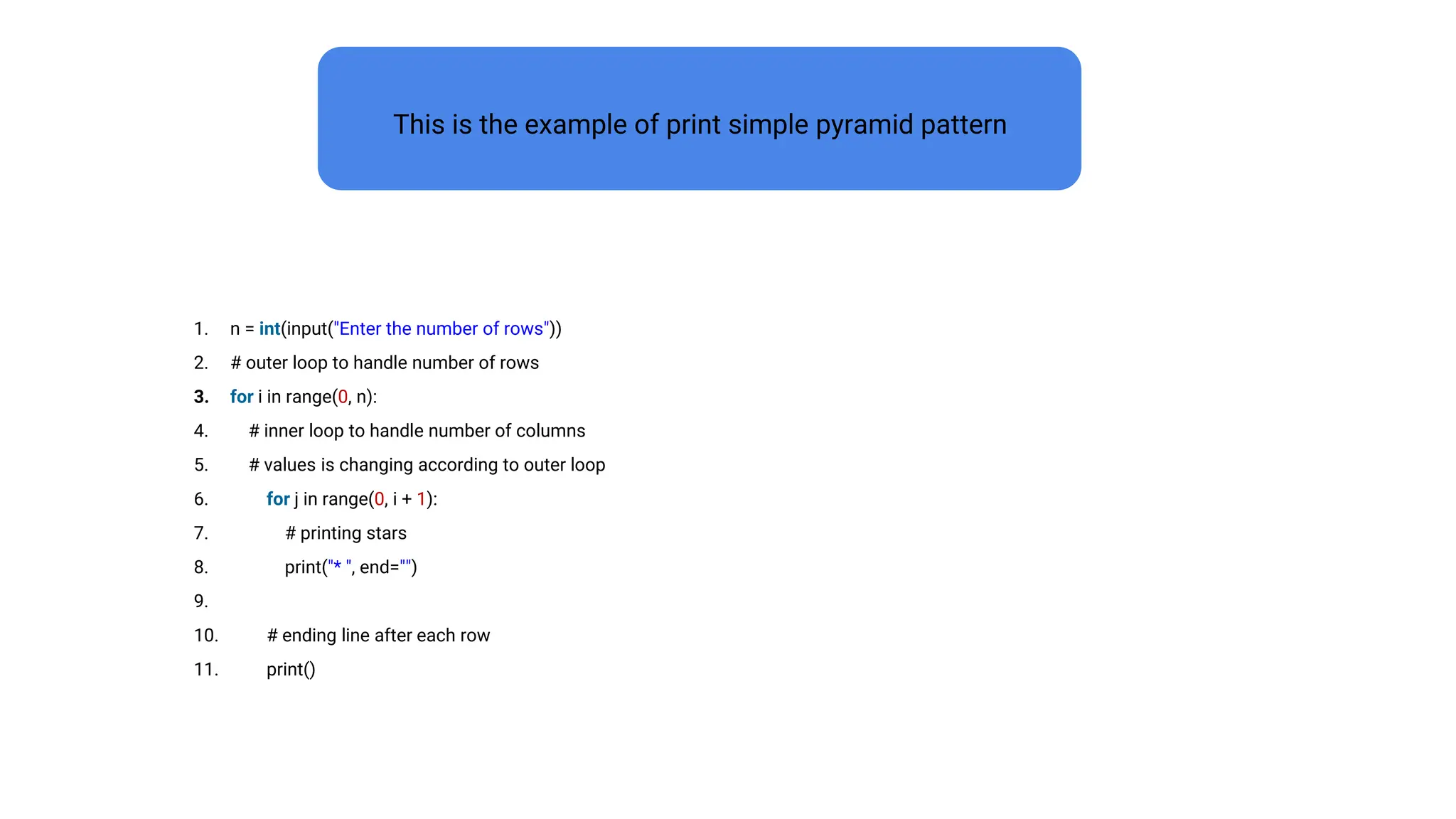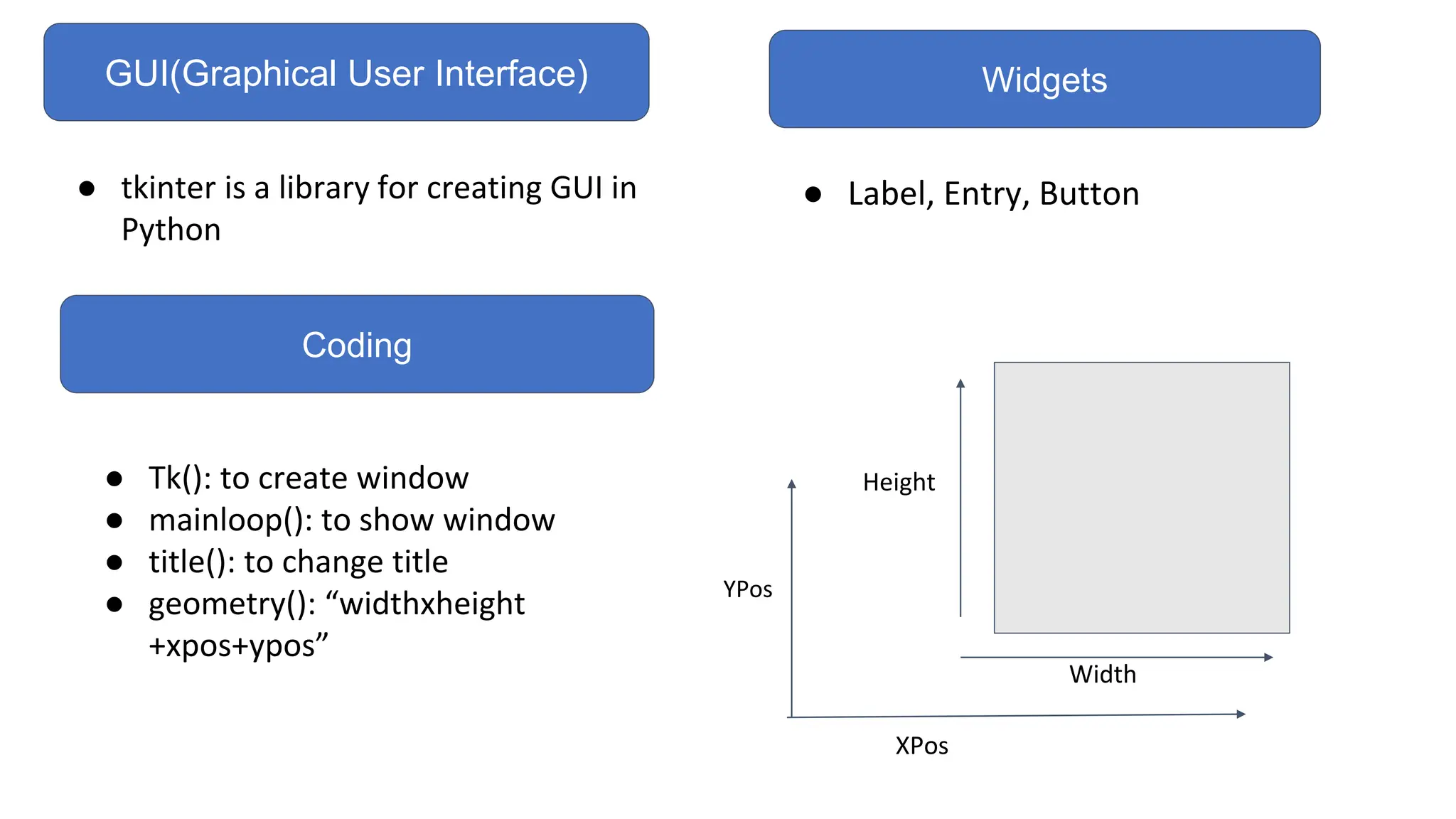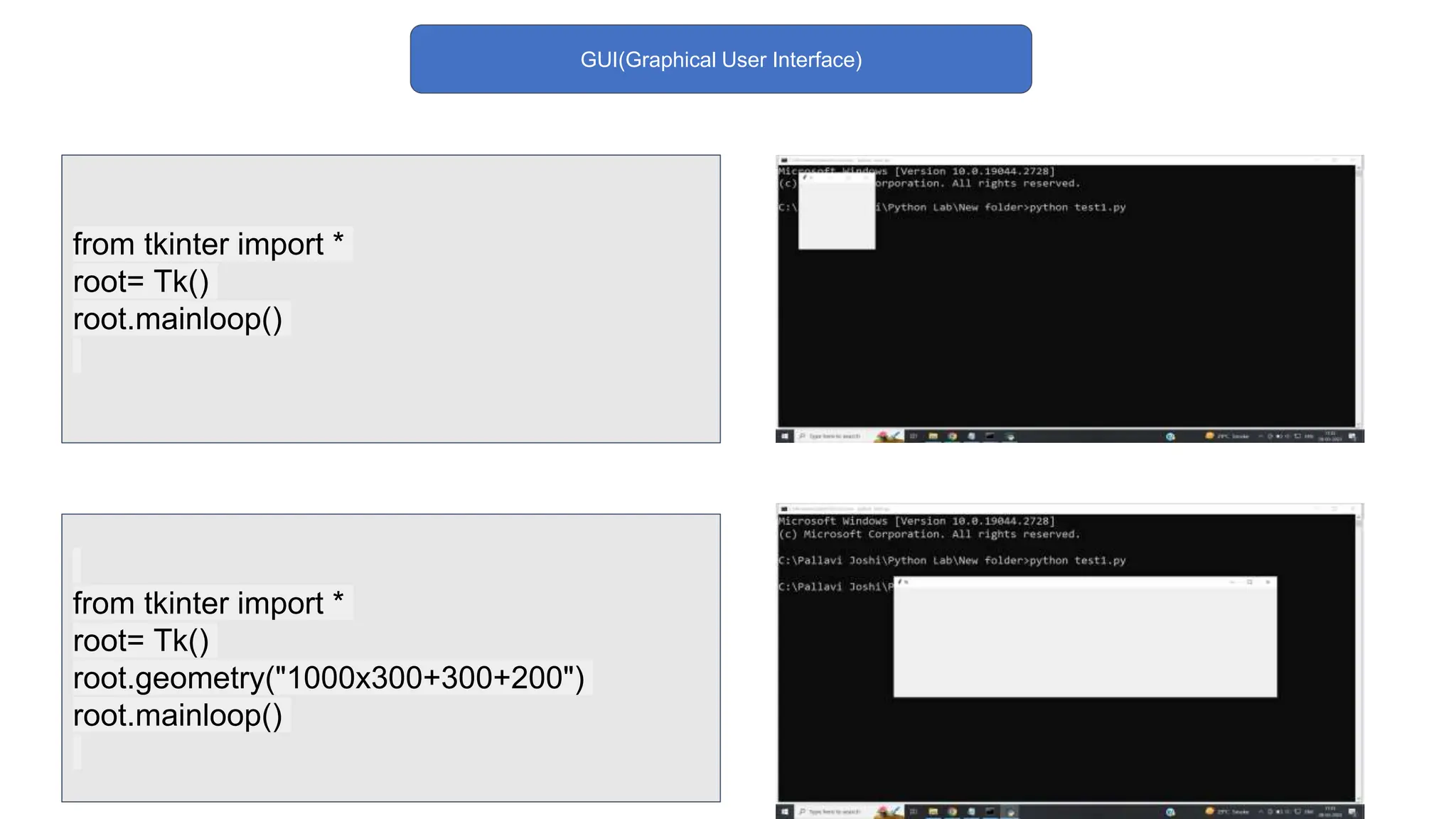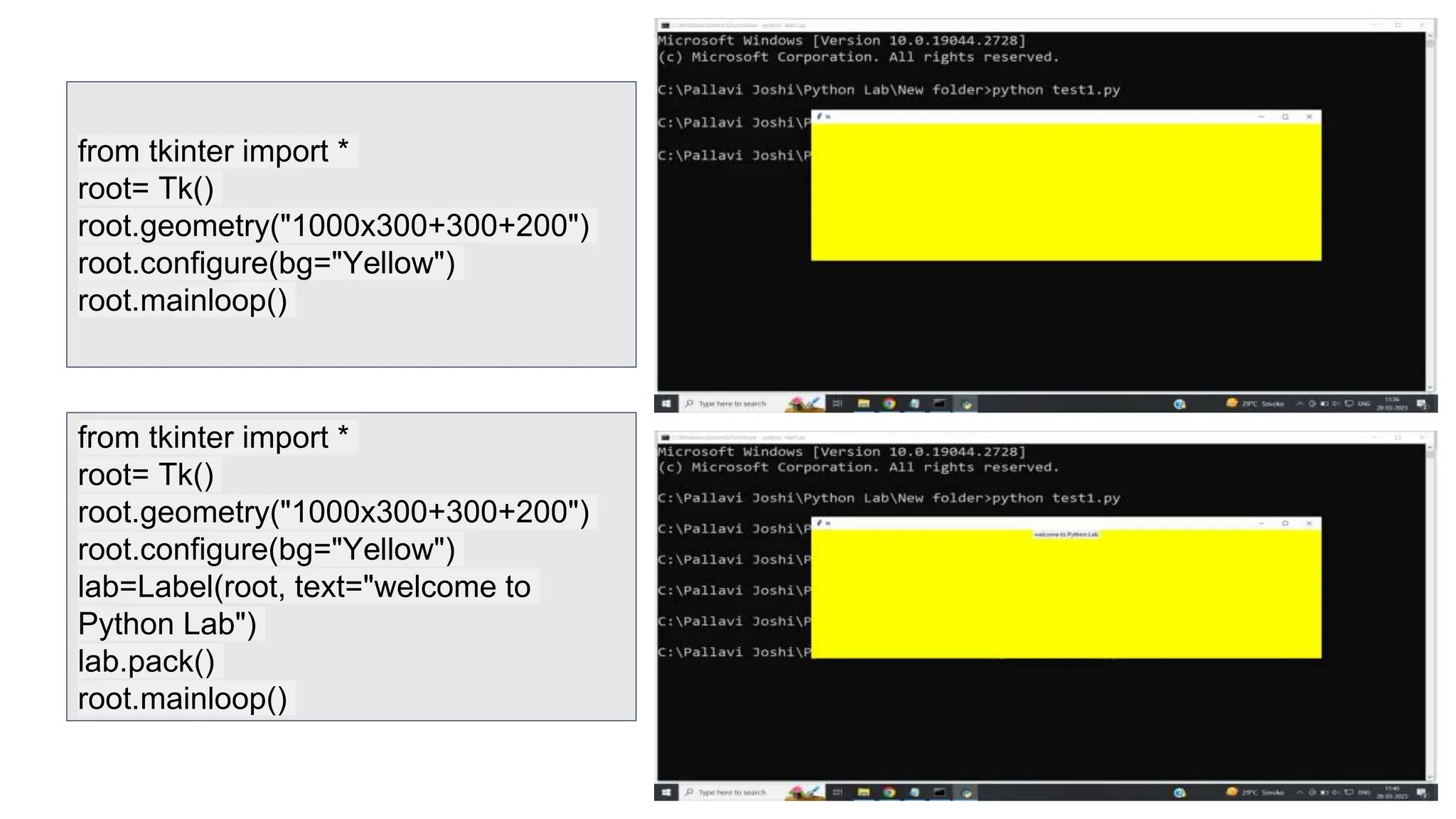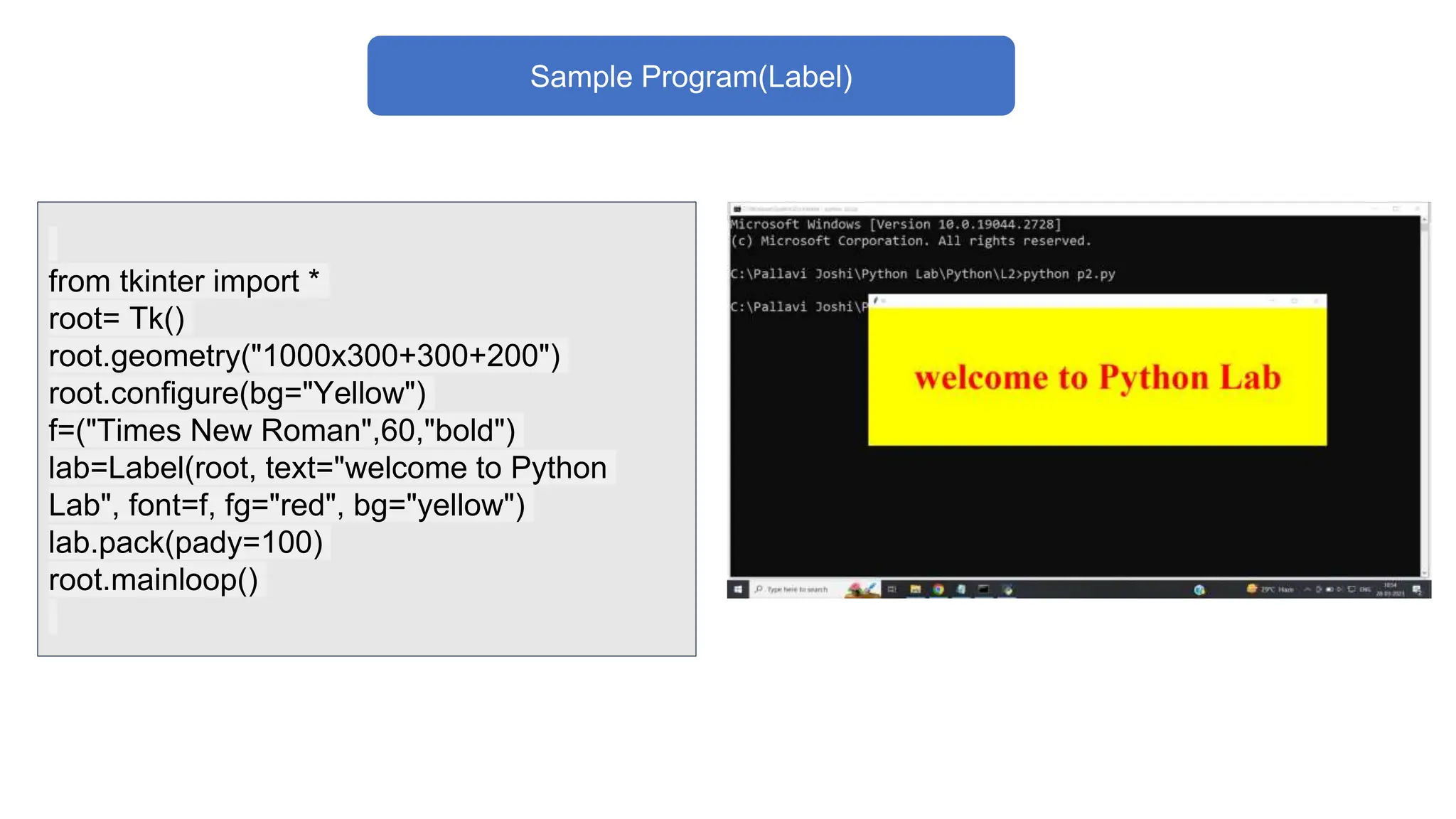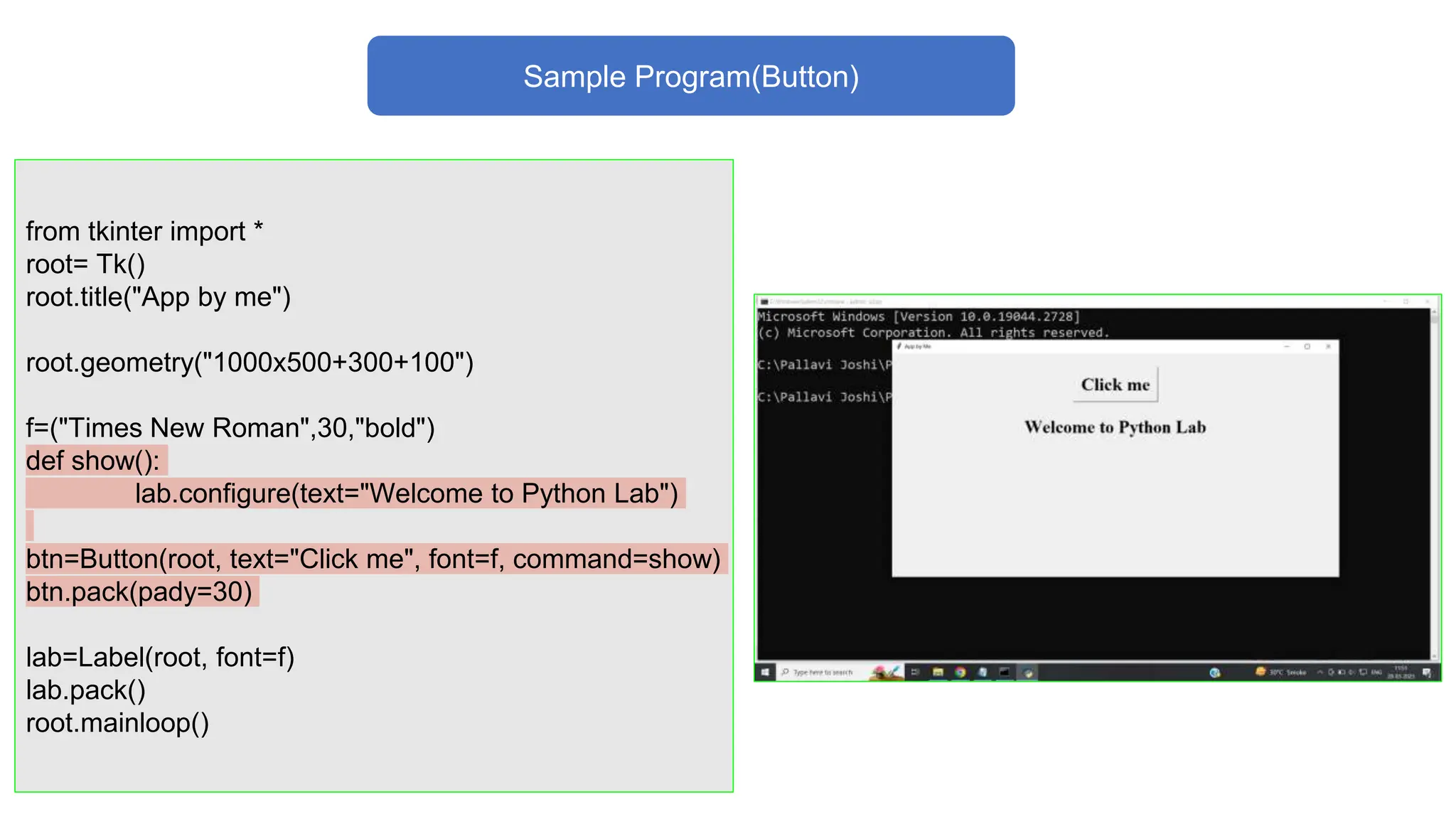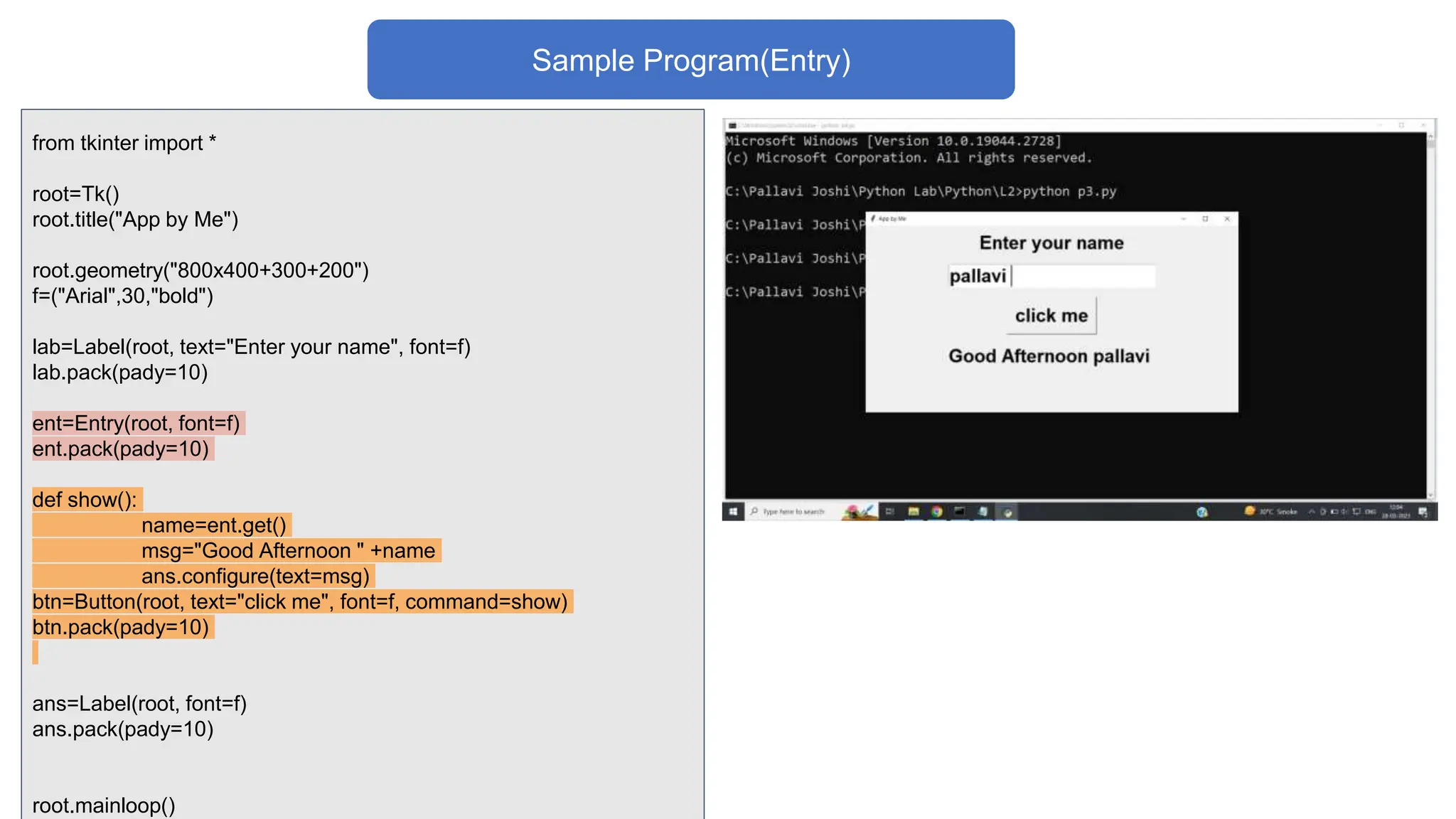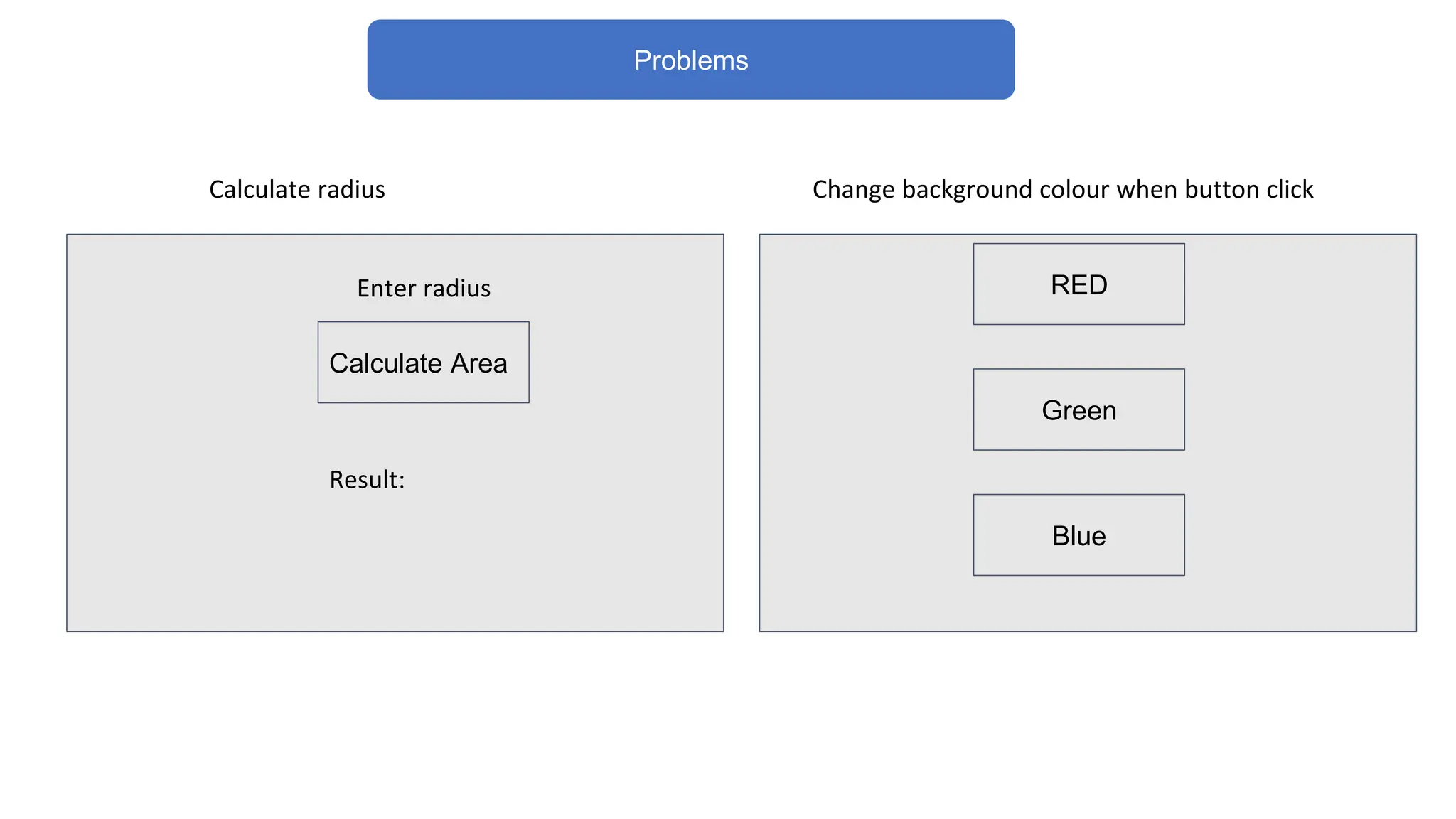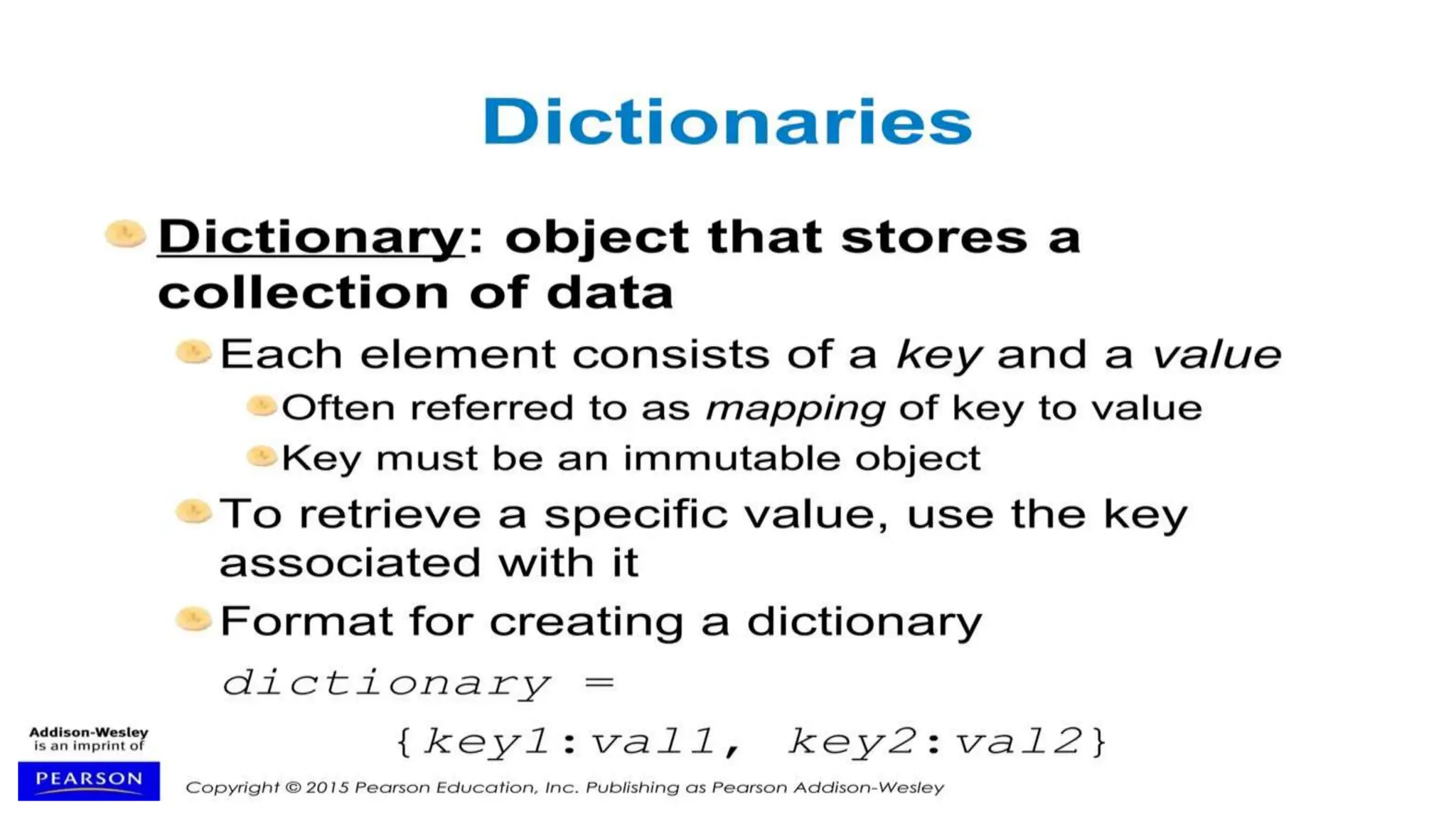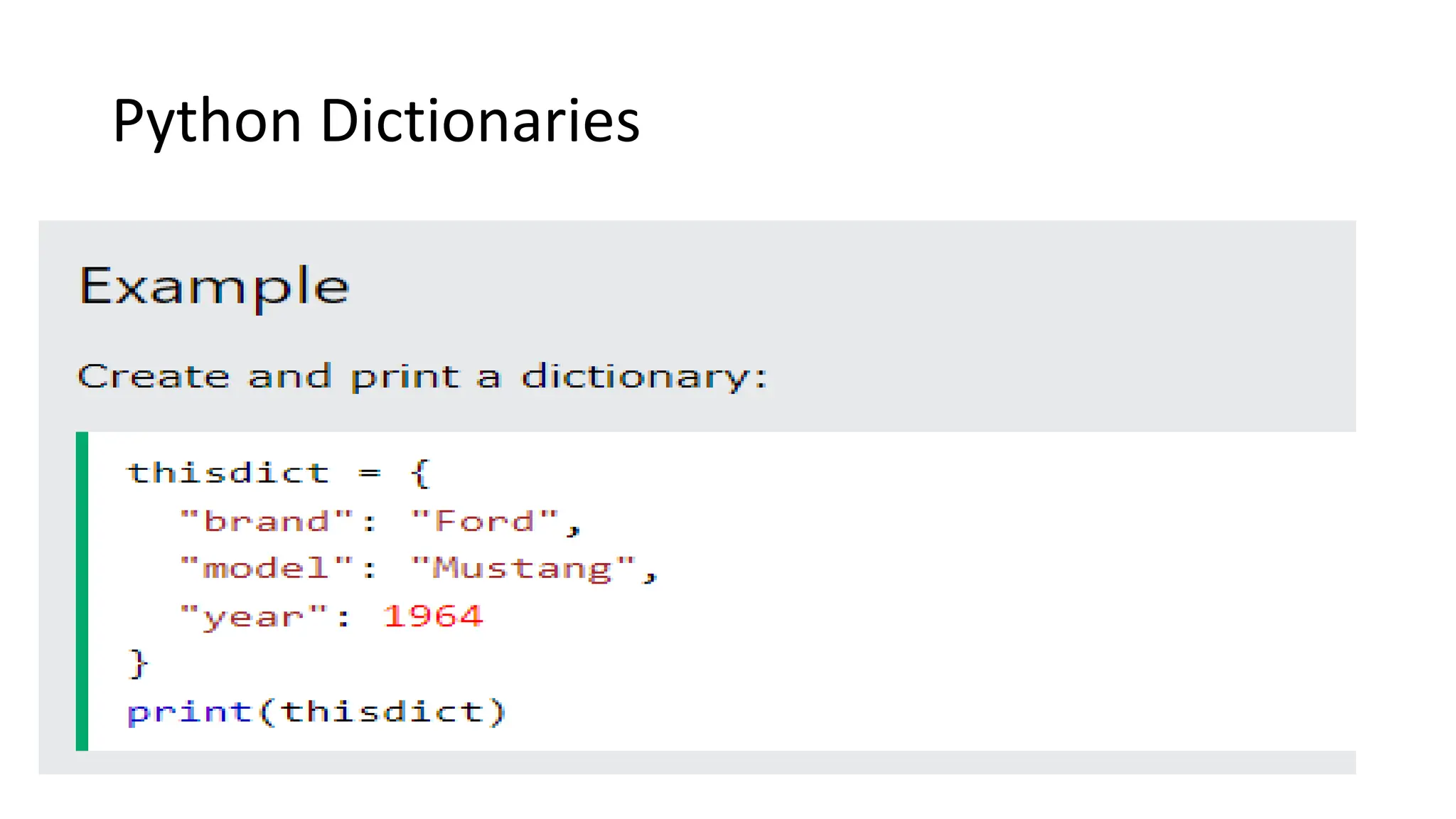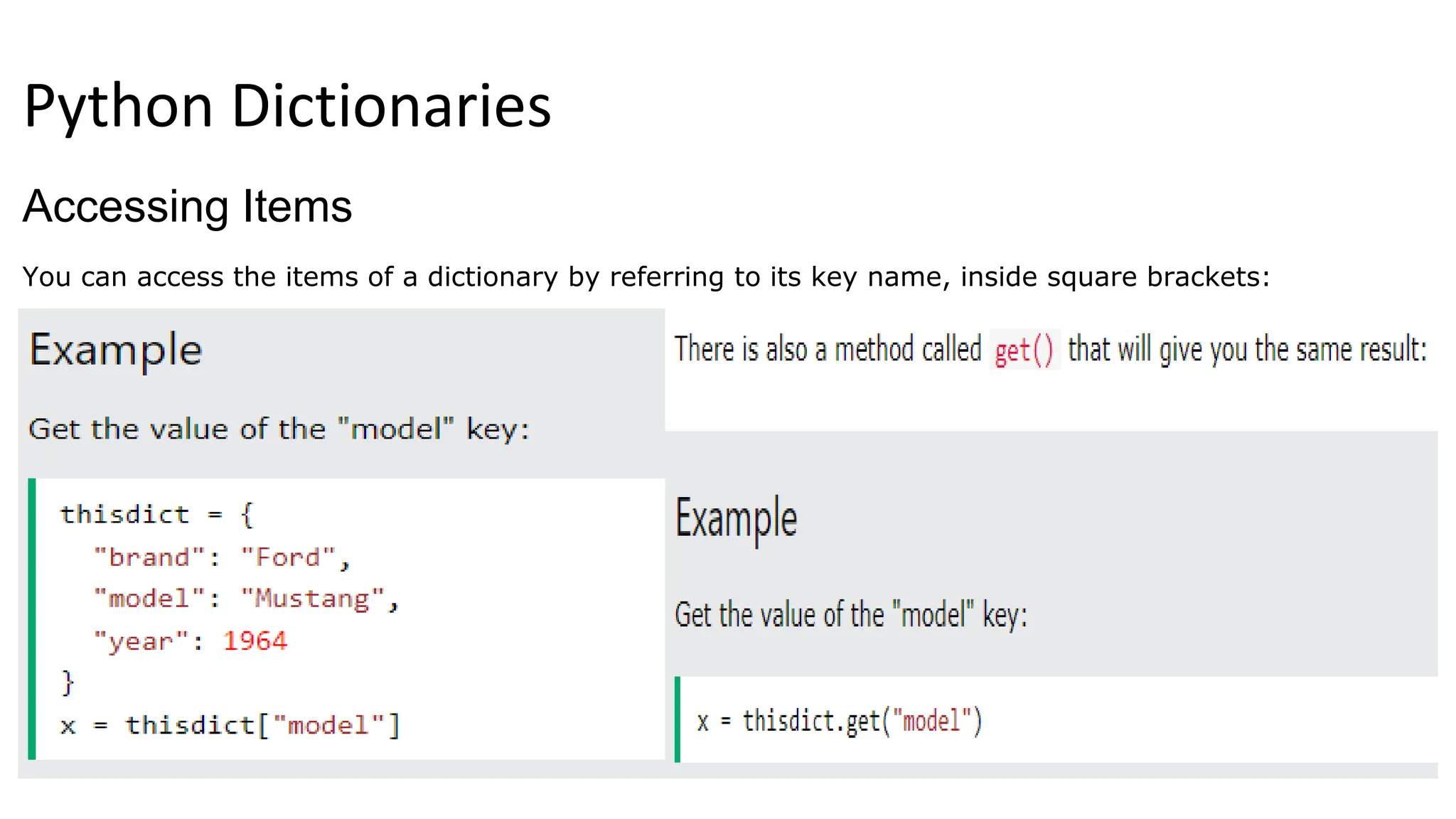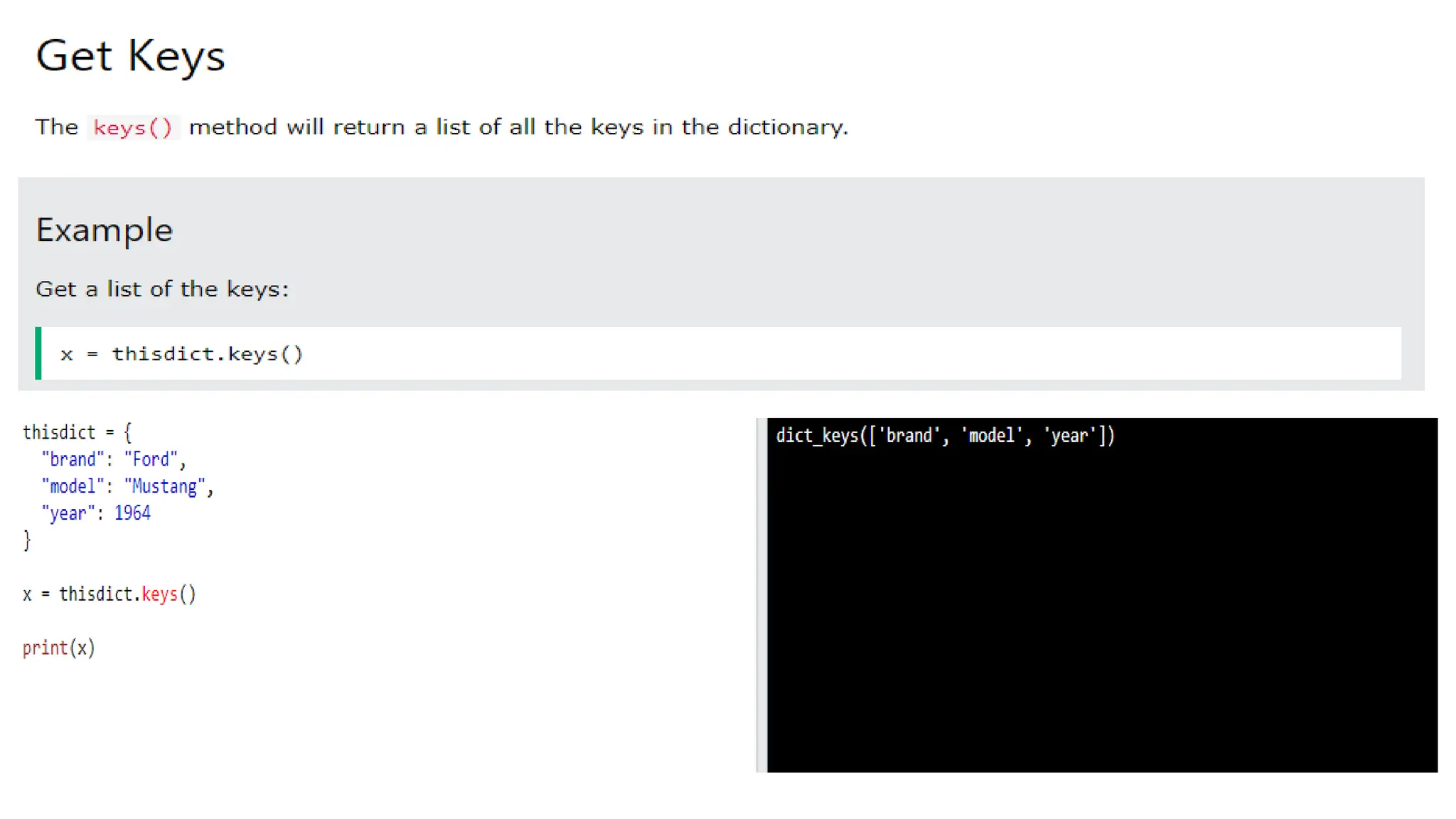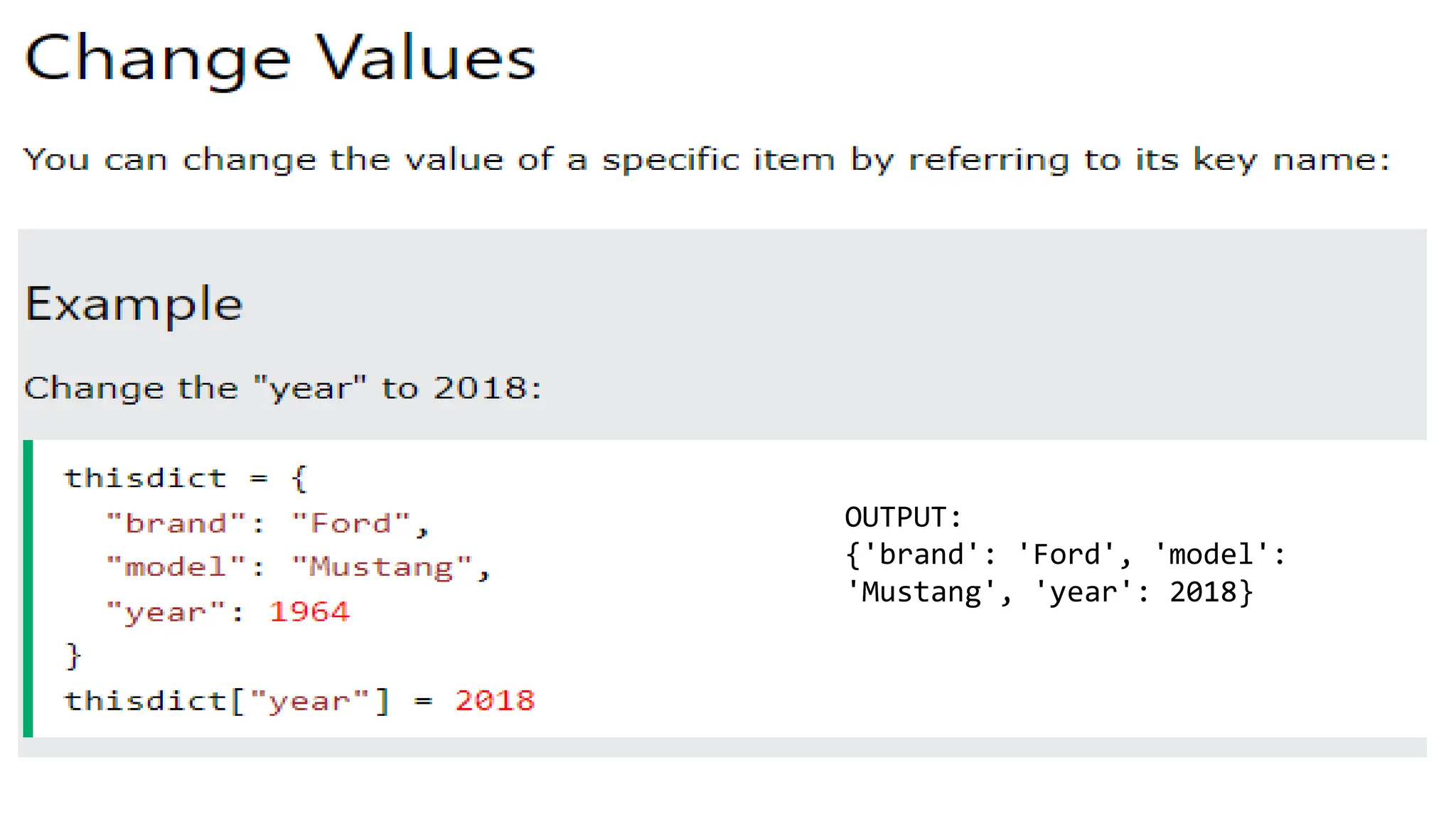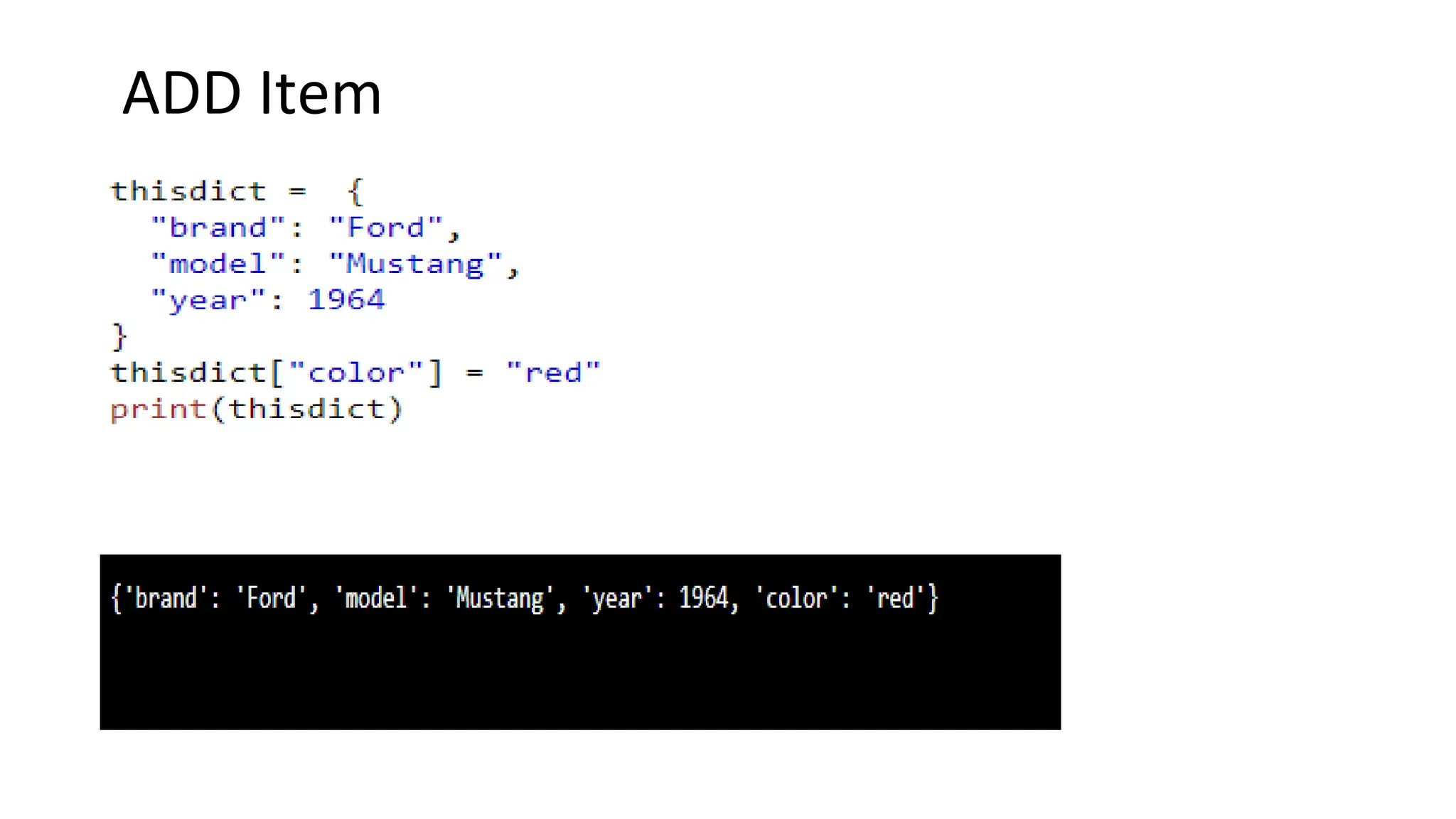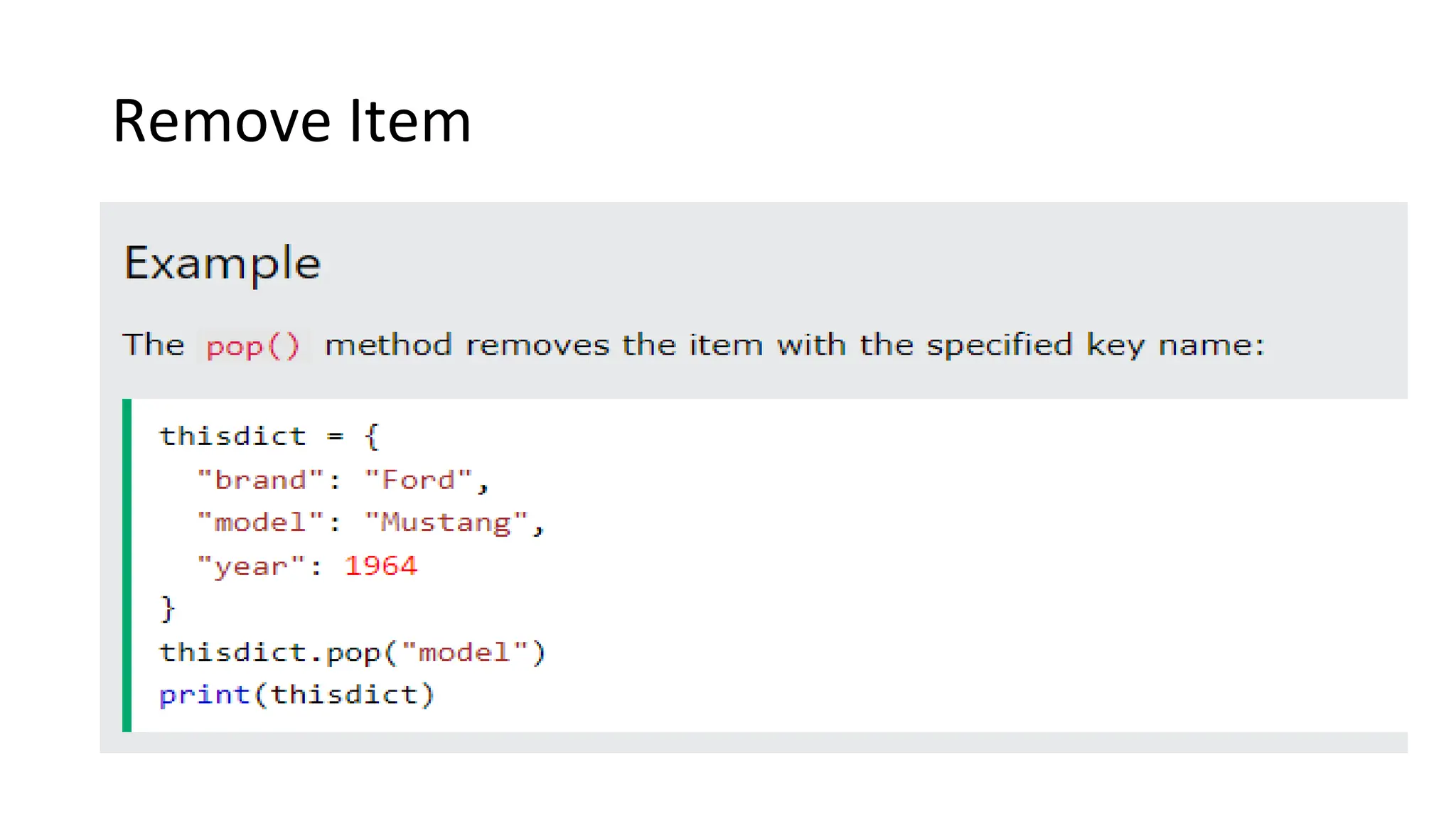The document provides an overview of Python programming concepts including data types, variables, operators, and collections like lists and tuples. It defines Python as a general purpose programming language created in 1991 that can be used for desktop, web, machine learning, and data science apps. Key data types covered include numbers, strings, lists, and tuples. Operators for arithmetic, comparison, logical, membership, and identity are also summarized. Various list and tuple methods for accessing, modifying, sorting, and joining their items are demonstrated through examples.
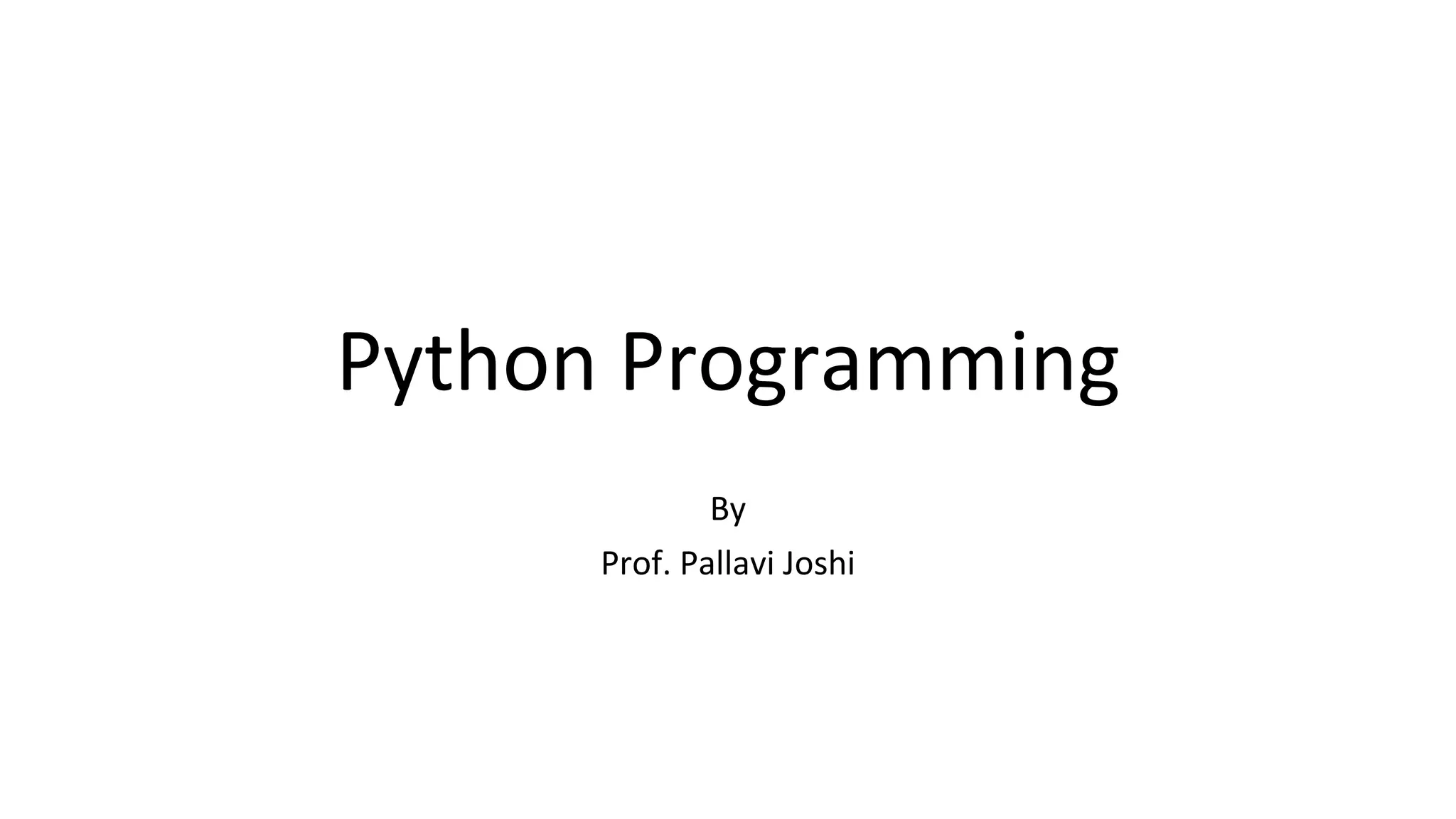
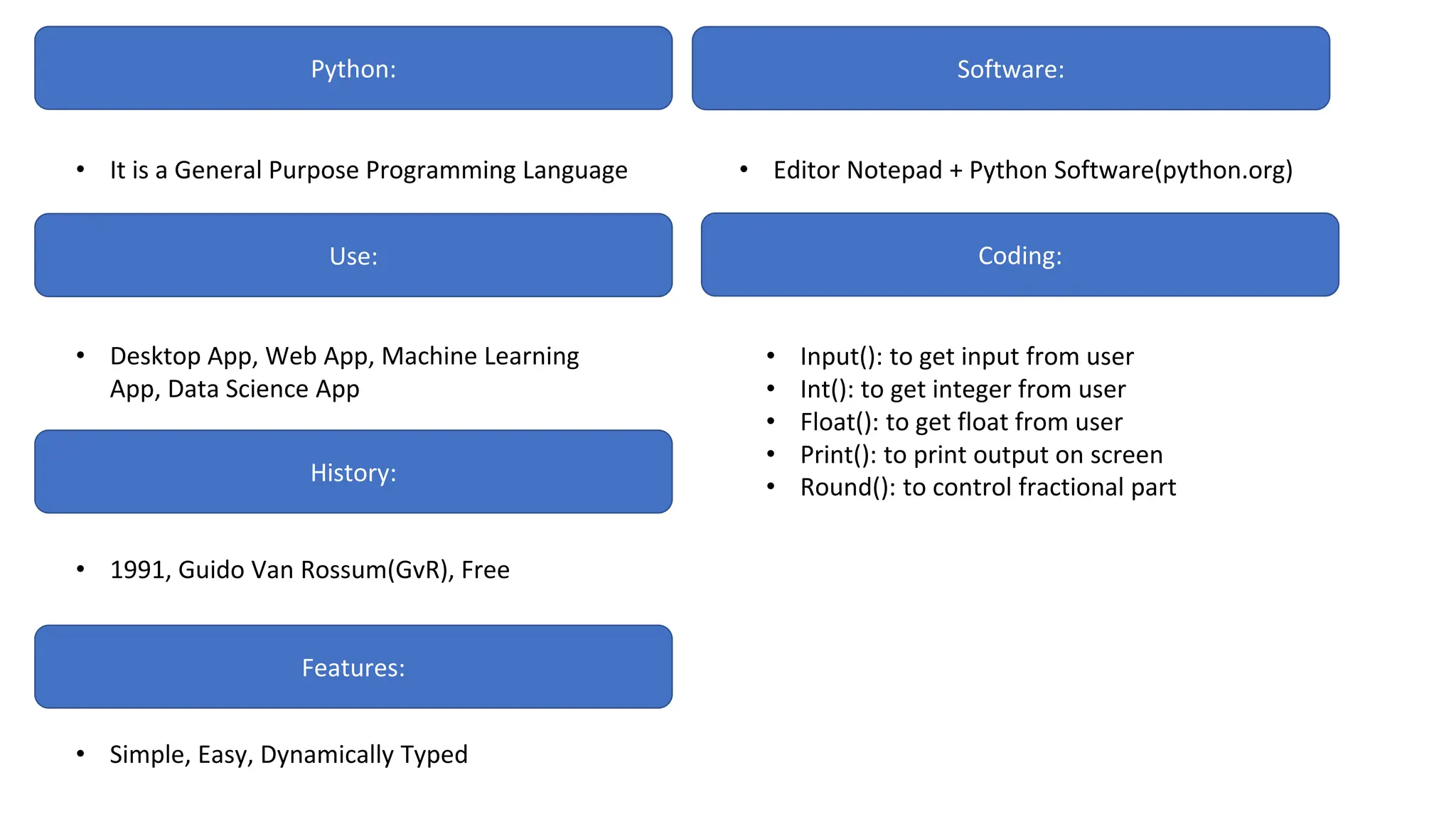
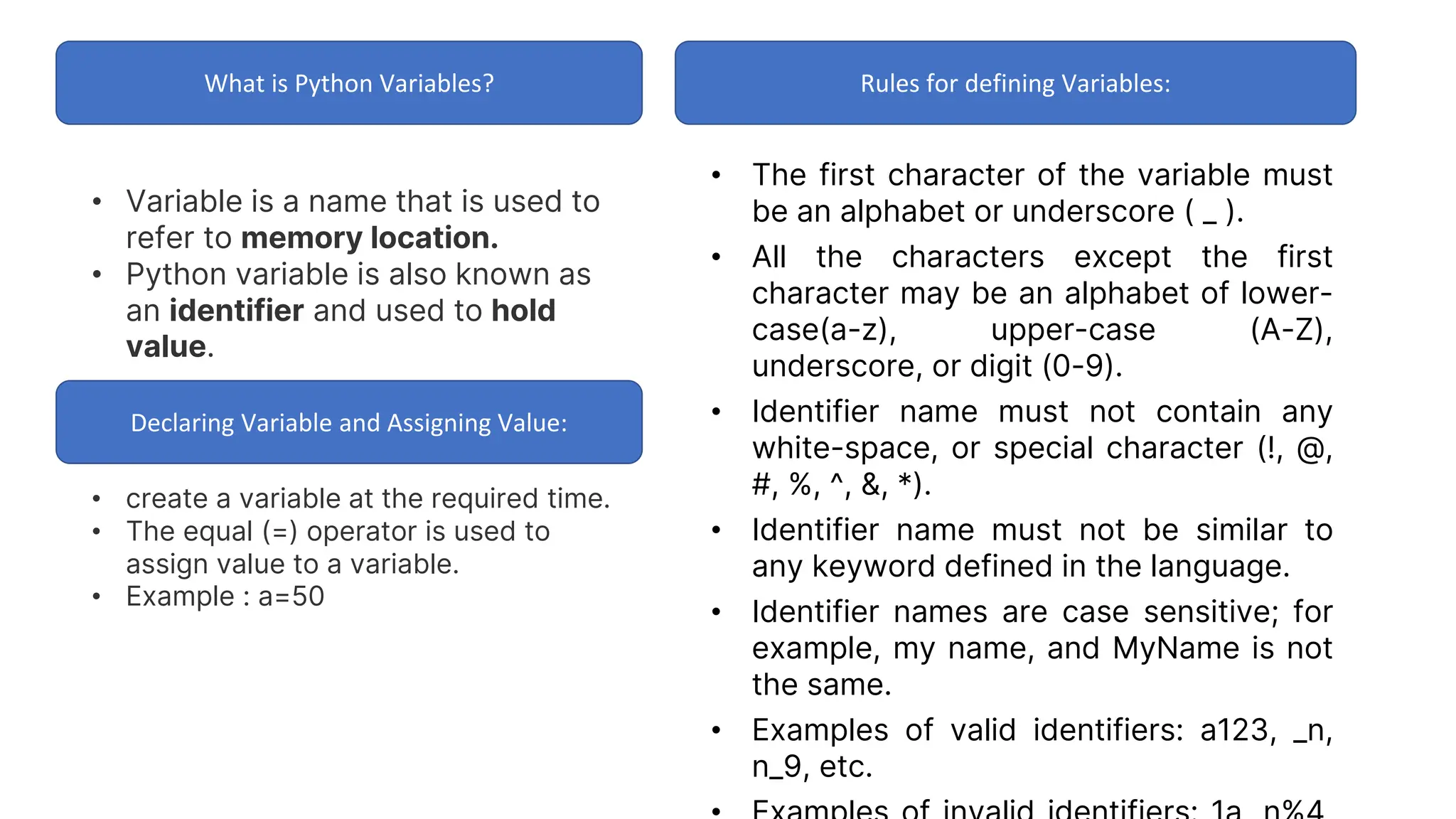
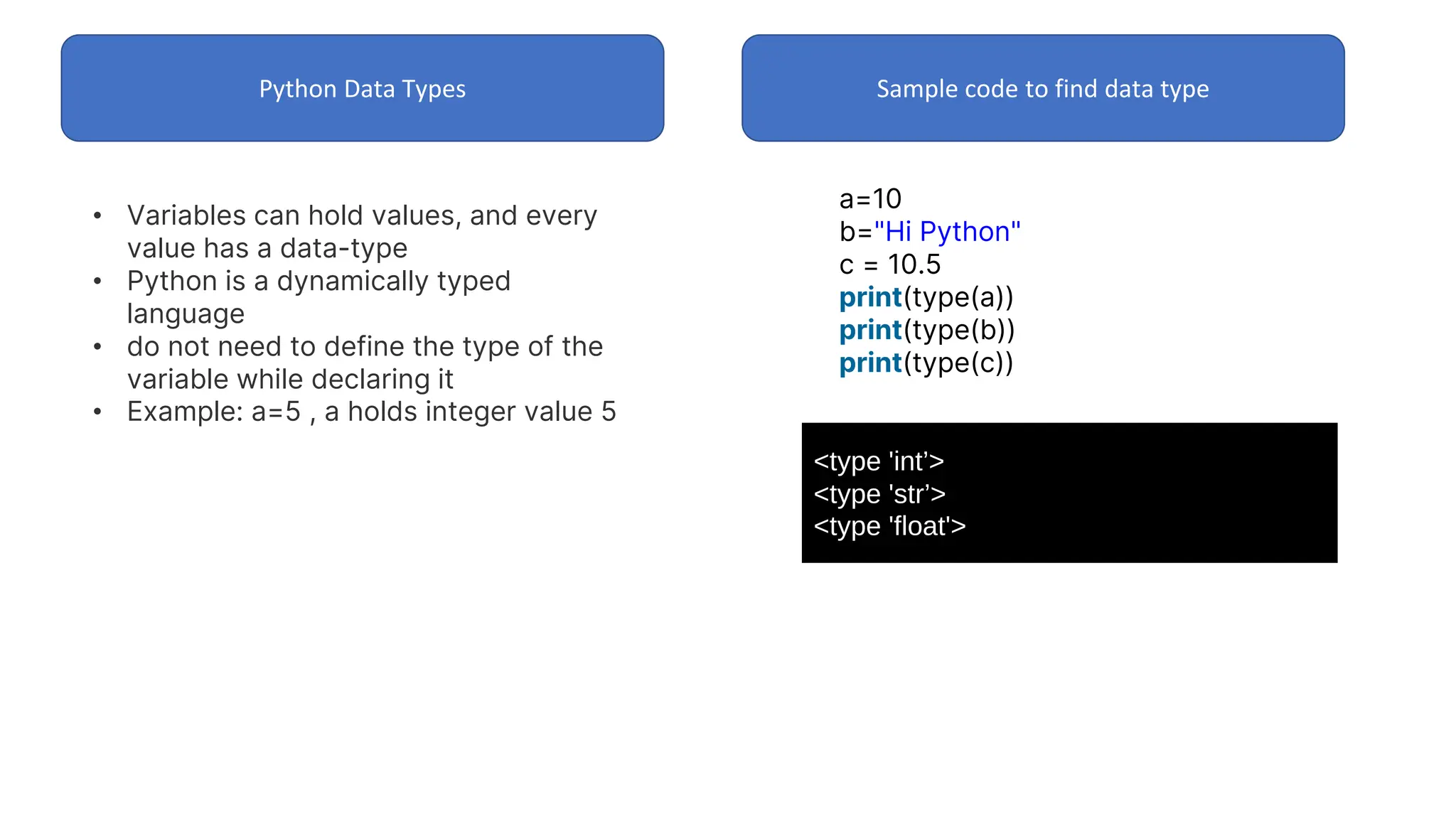
![Numbers:
• Number stores numeric values.
• integer, float, and complex values are
Numbers data-type
• type() function to know the data-type of
the variable
a=5
print("The type of a", type(a))
b=40.5
print("The type of b", type(b))
c=1+3j
print("The type of c", type(c))
The type of a <class 'int’>
The type of b <class 'float’>
The type of c <class 'complex'>
String:
• string can be defined as the sequence
of characters represented in the
quotation marks. (“abc”)
• the operator + is used to concatenate
two strings
• operator * is known as a repetition
operator
str1='hello javatpoint' #string str1
str2=' how are you' #string str2
print(str1[0:2]) #printing first two character u
sing slice operator
print(str1[4]) #printing 4th character of the s
tring
print(str1*2) #printing the string twice
print(str1+str2) #printing the concatenation o
f str1 and str2
he
o
hello javatpointhello javatpoint
hello javatpoint how are you](https://image.slidesharecdn.com/pythonprogramming-240413151503-8fa7dc50/75/Python-Programming-for-basic-beginners-pptx-5-2048.jpg)
![Python Strings
• Strings in python are
surrounded by either single
quotation marks, or double
quotation marks.
• Example: ‘Hello’ Or “Hello”
Assign String to Variable
a = "Hello"
print(a)
Multiline String(with three double
quotes)
a = """You can assign a
multiline string to a variable
by using three quotes."""
print(a)
Multiline String(with three single
quotes)
a = '''You can assign a
multiline string to a
variable by using three
quotes.'''
print(a)
Strings are Arrays
• Python does not have a
character data type, a
single character is
simply a string with a
length of 1.
a = "Hello, World!"
print(a[1])
Looping through a string
for x in "banana":
print(x)
b
a
n
a
n
a](https://image.slidesharecdn.com/pythonprogramming-240413151503-8fa7dc50/75/Python-Programming-for-basic-beginners-pptx-6-2048.jpg)
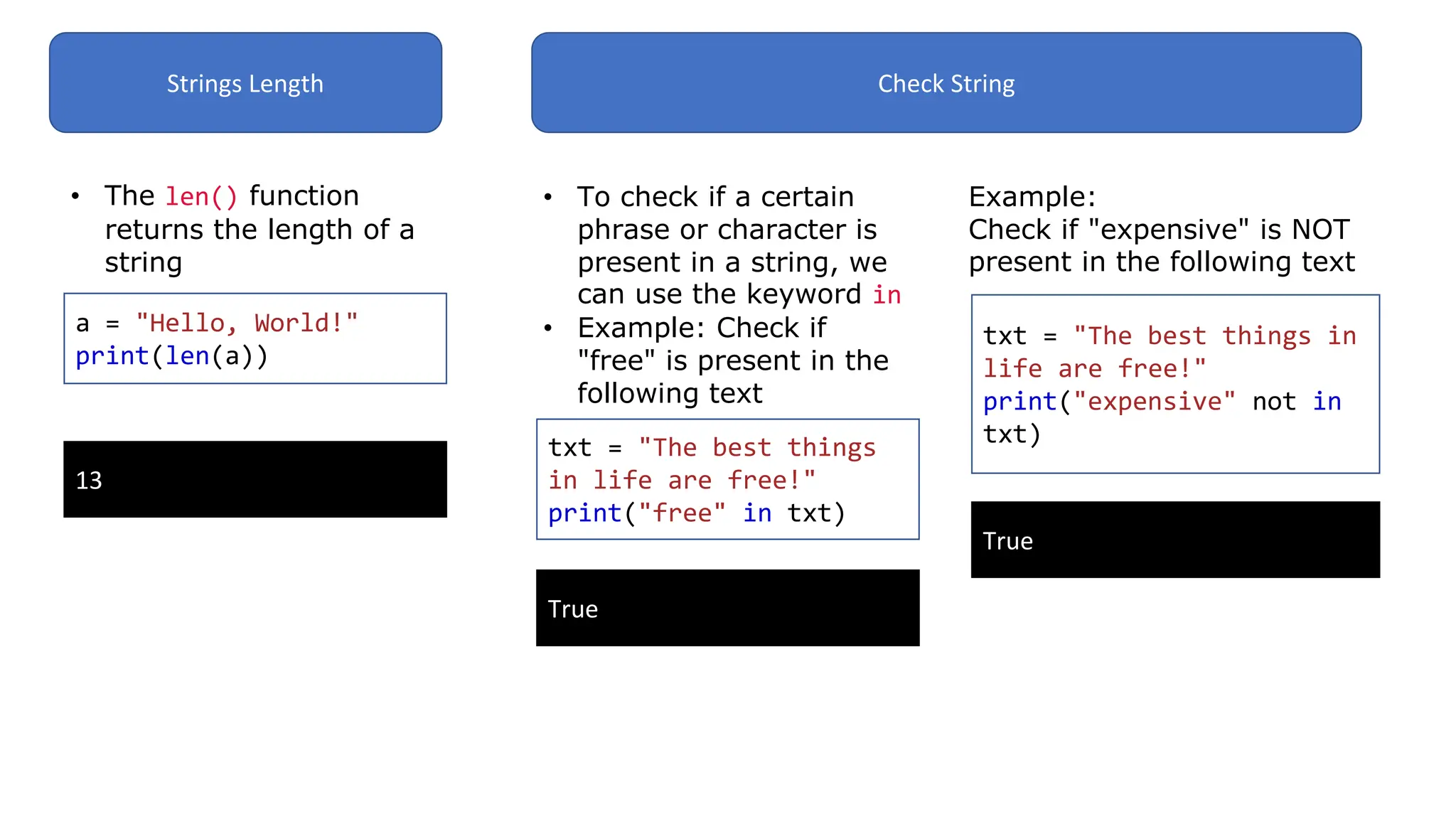
![Python List
• Lists are used to store multiple
items in a single variable
• Example: Create a Lists
thislist =
["apple", "banana", "cherry"]
print(thislist)
['apple', 'banana', 'cherry']
Access Items
thislist =
["apple", "banana", "cherry"]
print(thislist[1])
Range of index
thislist =
["apple", "banana", "cherry"
, "orange", "kiwi", "melon",
"mango"]
print(thislist[2:5])
['cherry', 'orange', 'kiwi']
Change list items
• To change the value of a
specific item, refer to the
index number.
thislist =
["apple", "banana", "cherry"]
thislist[1] = "blackcurrant"
print(thislist)
Change range of item value
• Change the values
"banana" and "cherry" with
the values "blackcurrant"
and "watermelon":
thislist =
["apple", "banana", "cher
ry", "orange", "kiwi", "m
ango"]
thislist[1:3] =
["blackcurrant", "waterme
lon"]
print(thislist)
['apple', 'blackcurrant',
'watermelon', 'orange',
'kiwi', 'mango']](https://image.slidesharecdn.com/pythonprogramming-240413151503-8fa7dc50/75/Python-Programming-for-basic-beginners-pptx-8-2048.jpg)
![Add list item
• To add an item to the
end of the list, use
the append() method
thislist =
["apple", "banana", "cherry"]
thislist.append("orange")
print(thislist)
['apple', 'banana', 'cherry',
'orange']
Insert into list
• To insert a list item at a
specified index, use
the insert() method
thislist =
["apple", "banana", "cherry"]
thislist.insert(1, "orange")
print(thislist)
['apple', 'orange', 'banana',
'cherry']
Extend List
• To append elements
from another list to
the current list, use
the extend() method
thislist =
["apple", "banana", "cherr
y"]
tropical =
["mango", "pineapple", "pa
paya"]
thislist.extend(tropical)
print(thislist)
['apple', 'banana',
'cherry', 'mango',
'pineapple', 'papaya']](https://image.slidesharecdn.com/pythonprogramming-240413151503-8fa7dc50/75/Python-Programming-for-basic-beginners-pptx-9-2048.jpg)
![Remove specified item
• The remove() method
removes the specified
item.
thislist =
["apple", "banana", "cherry"]
thislist.remove("banana")
print(thislist)
['apple', 'cherry']
thislist =
["apple", "banana", "cherry"
]
thislist.pop(1)
print(thislist)
Remove specified index
• The pop() method
removes the specified
index.
['apple', 'cherry']
Remove specified index
• The del keyword also
removes the specified
index
thislist =
["apple", "banana", "cherr
y"]
del thislist[1]
print(thislist)
['apple', 'cherry']](https://image.slidesharecdn.com/pythonprogramming-240413151503-8fa7dc50/75/Python-Programming-for-basic-beginners-pptx-10-2048.jpg)
![Sort list Copy List Join List
• List objects have
a sort() method that will
sort the list
alphanumerically, ascending,
by default
thislist =
["orange", "mango", "kiwi",
"pineapple", "banana"]
thislist.sort()
print(thislist)
['banana', 'kiwi', 'mango',
'orange', 'pineapple']
• A copy of a list with
the copy() method.
• A copy of a list with
the list() method
thislist =
["apple", "banana", "cher
ry"]
mylist = thislist.copy()
print(mylist)
thislist =
["apple", "banana", "cher
ry"]
mylist = list(thislist)
print(mylist)
['apple', 'banana',
'cherry']
• using the + operator
• Using append()
• Using extend()
list1 =
["a", "b" , "c"]
list2 = [1, 2, 3]
list3 = list1 + list2
print(list3)
for x in list2:
list1.append(x)
print(list1)
list1.extend(list2)
print(list1)](https://image.slidesharecdn.com/pythonprogramming-240413151503-8fa7dc50/75/Python-Programming-for-basic-beginners-pptx-11-2048.jpg)
![Python Tuples Tuple Items Access Tuple Items
• Tuples are used to store
multiple items in a single
variable
• A tuple is a collection which
is ordered and
unchangeable
• Tuples are written with
round brackets
thistuple = ("apple",
"banana", "cherry")
print(thistuple)
('apple', 'banana', 'cherry')
• Tuple items are ordered,
unchangeable, and allow
duplicate values.
• Tuple items are indexed, the
first item has index [0], the
second item has index [1] etc.
• ex. Allow duplicates
thistuple = ("apple",
"banana", "cherry",
"apple", "cherry")
print(thistuple) banana
• access tuple items by
referring to the index
number, inside square
brackets
thistuple = ("apple",
"banana", "cherry")
print(thistuple[1])
('apple', 'banana', 'cherry',
'apple', 'cherry')](https://image.slidesharecdn.com/pythonprogramming-240413151503-8fa7dc50/75/Python-Programming-for-basic-beginners-pptx-12-2048.jpg)
![Negative Indexing Range of Indexes Access Tuple Items
• Negative indexing means
start from the end.
• -1 refers to the last item, -
2 refers to the second last
item etc.
thistuple = ("apple",
"banana", "cherry")
print(thistuple[-1])
cherry
• specify a range of indexes by
specifying where to start and
where to end the range.
• When specifying a range, the
return value will be a new
tuple with the specified items
• The search will start at index 2
(included) and end at index 5
(not included).
thistuple = ("apple",
"banana", "cherry",
"orange", "kiwi", "melon",
"mango")
print(thistuple[2:5])
banana
• access tuple items by
referring to the index
number, inside square
brackets
thistuple = ("apple",
"banana", "cherry")
print(thistuple[1])
('cherry', 'orange', 'kiwi')](https://image.slidesharecdn.com/pythonprogramming-240413151503-8fa7dc50/75/Python-Programming-for-basic-beginners-pptx-13-2048.jpg)
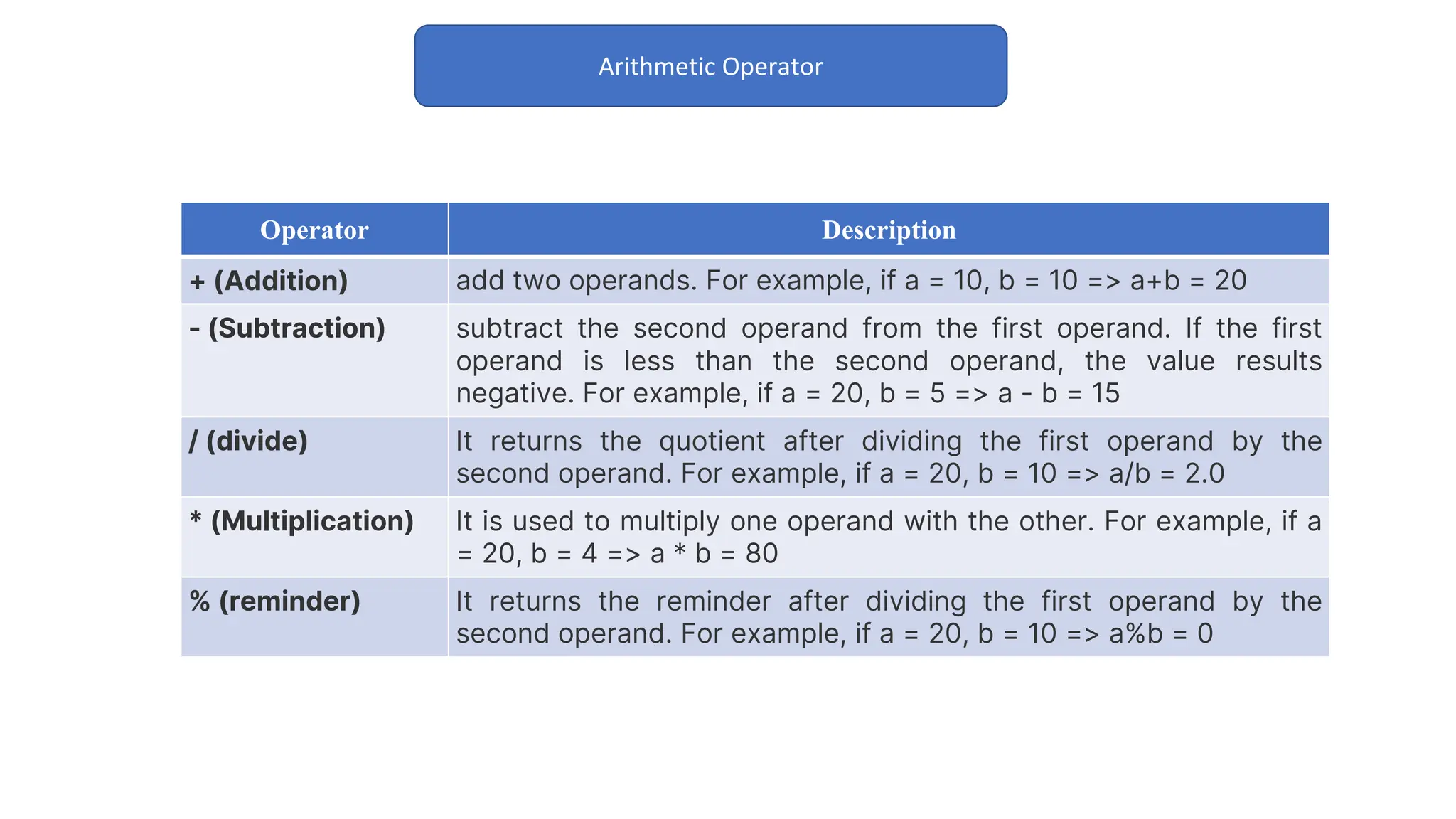
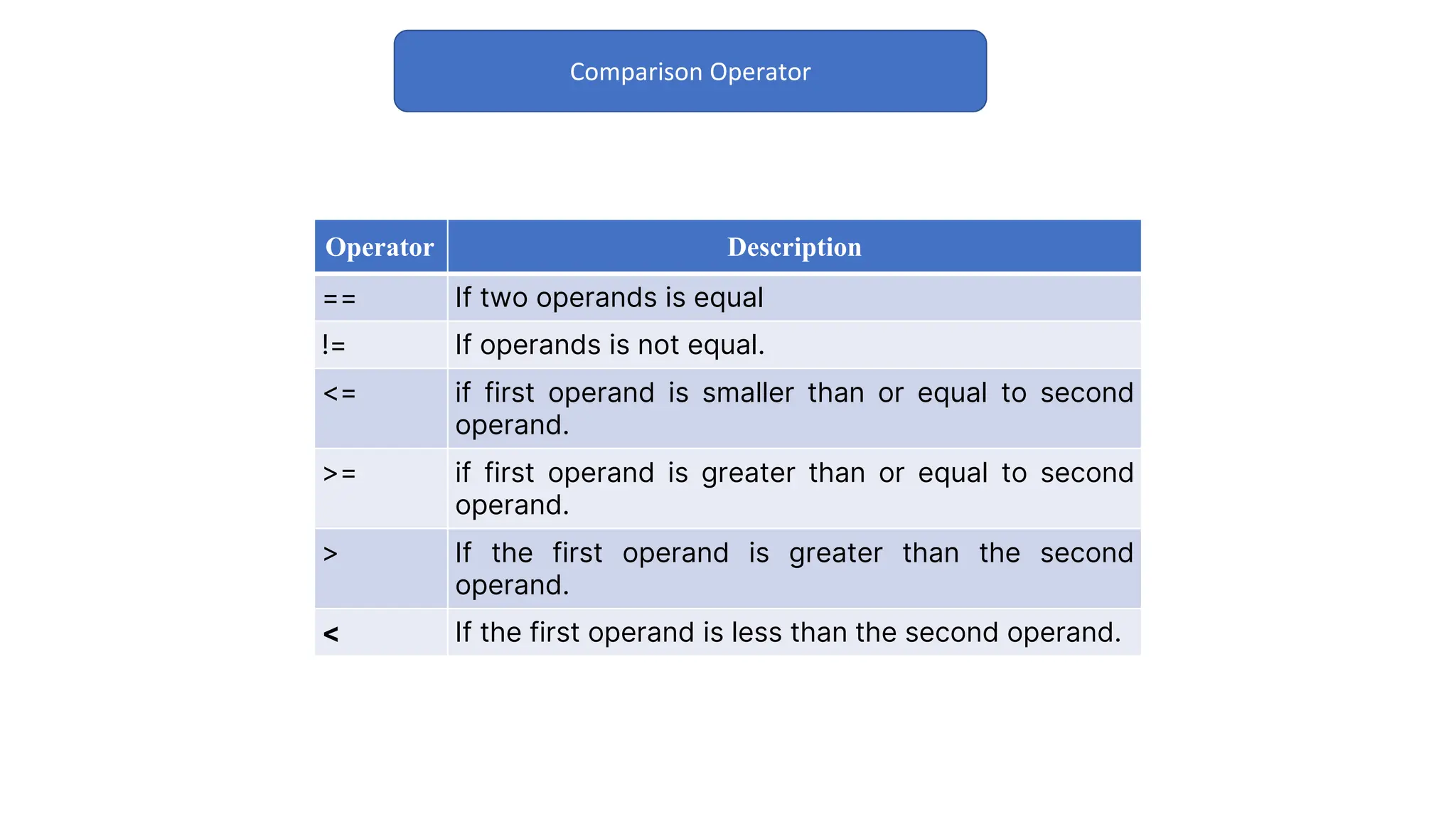
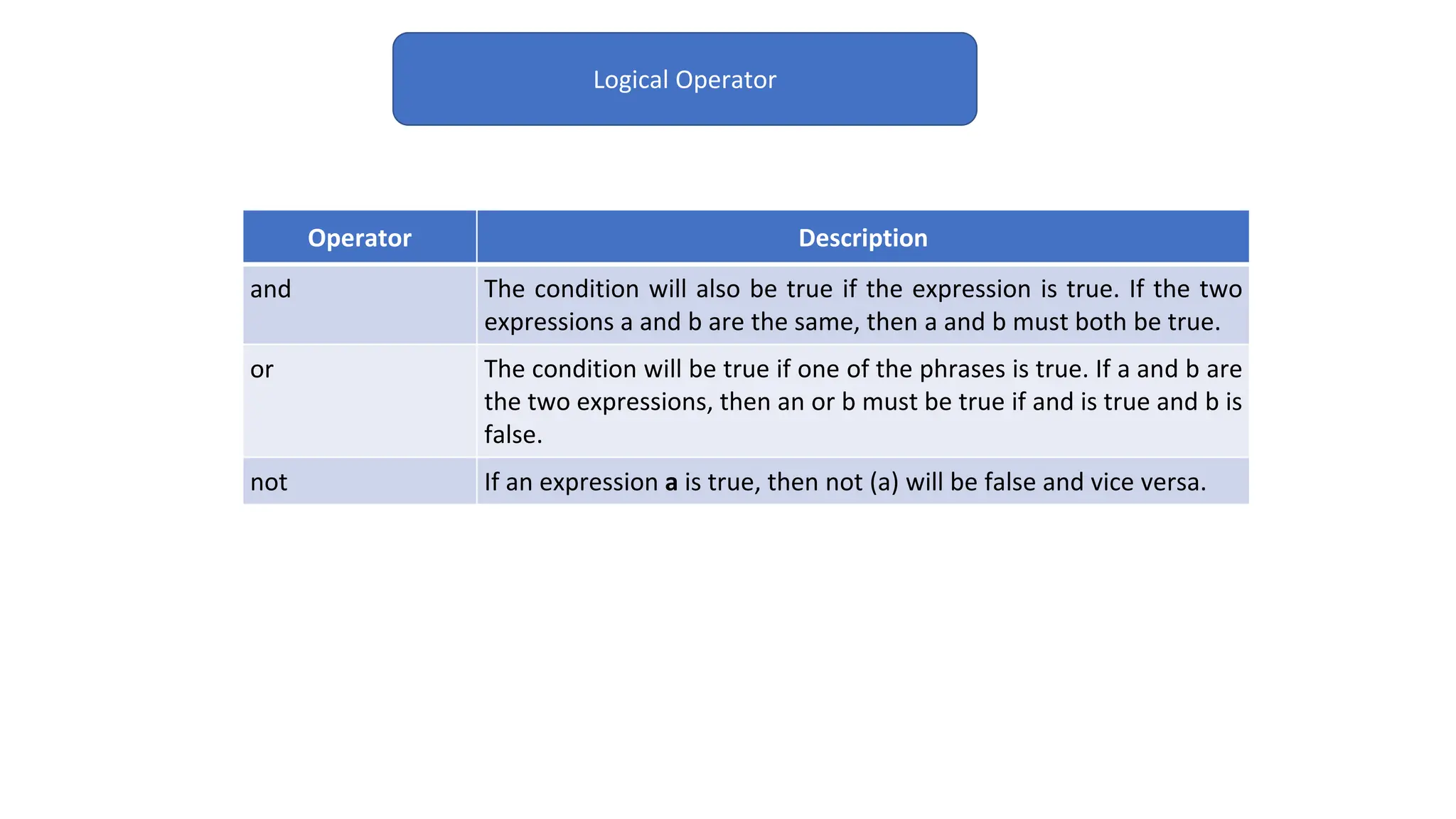
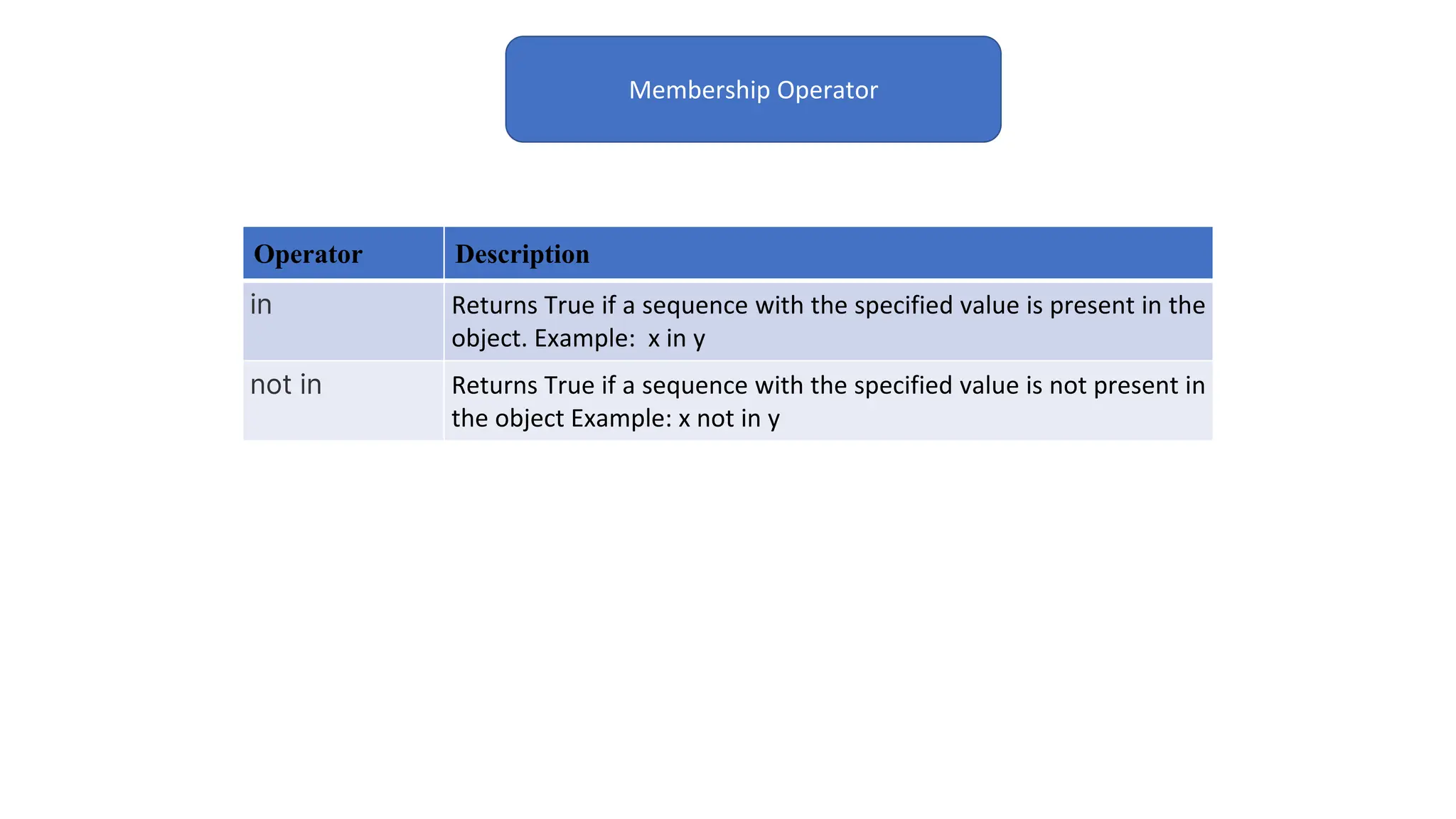
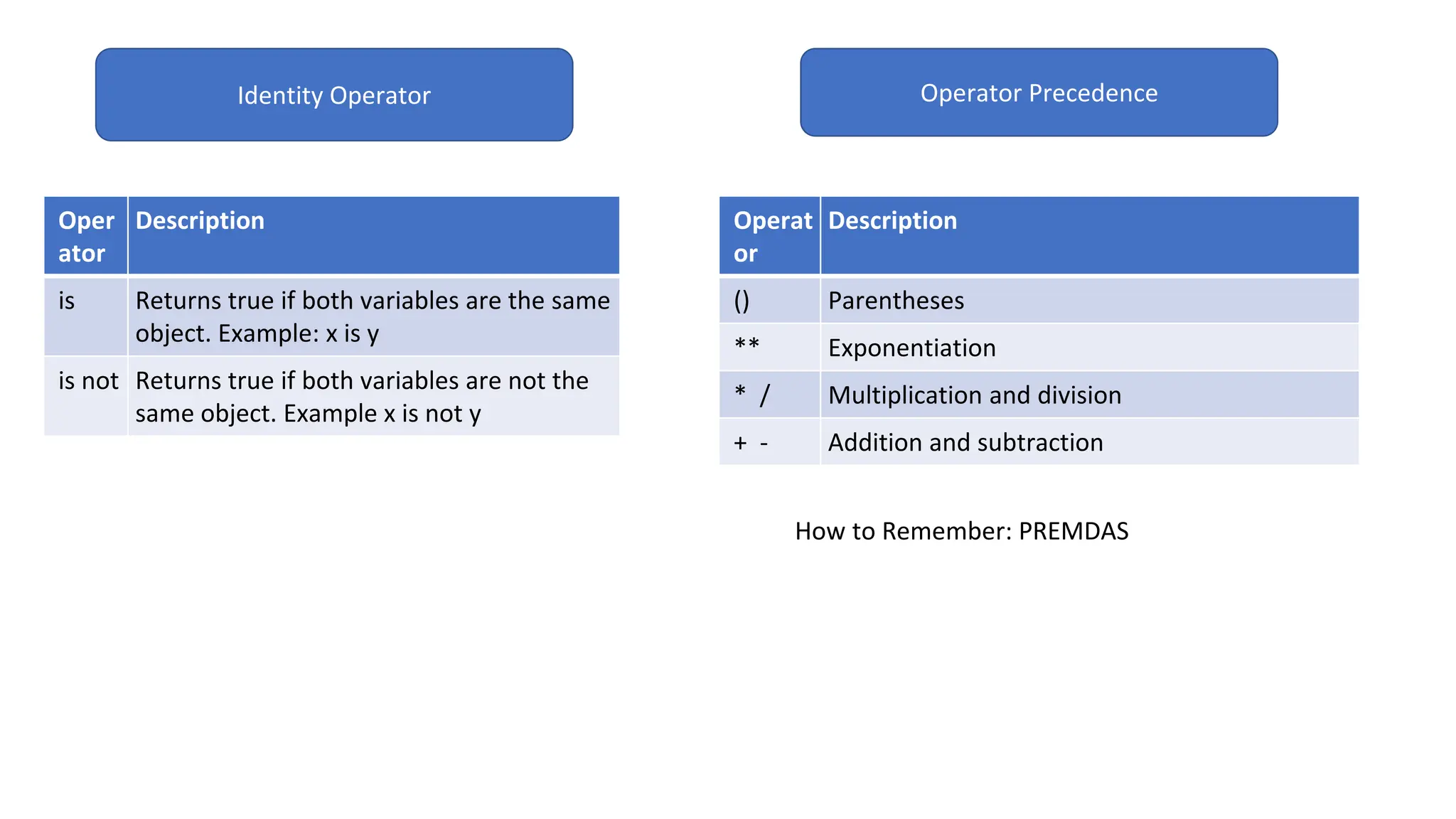
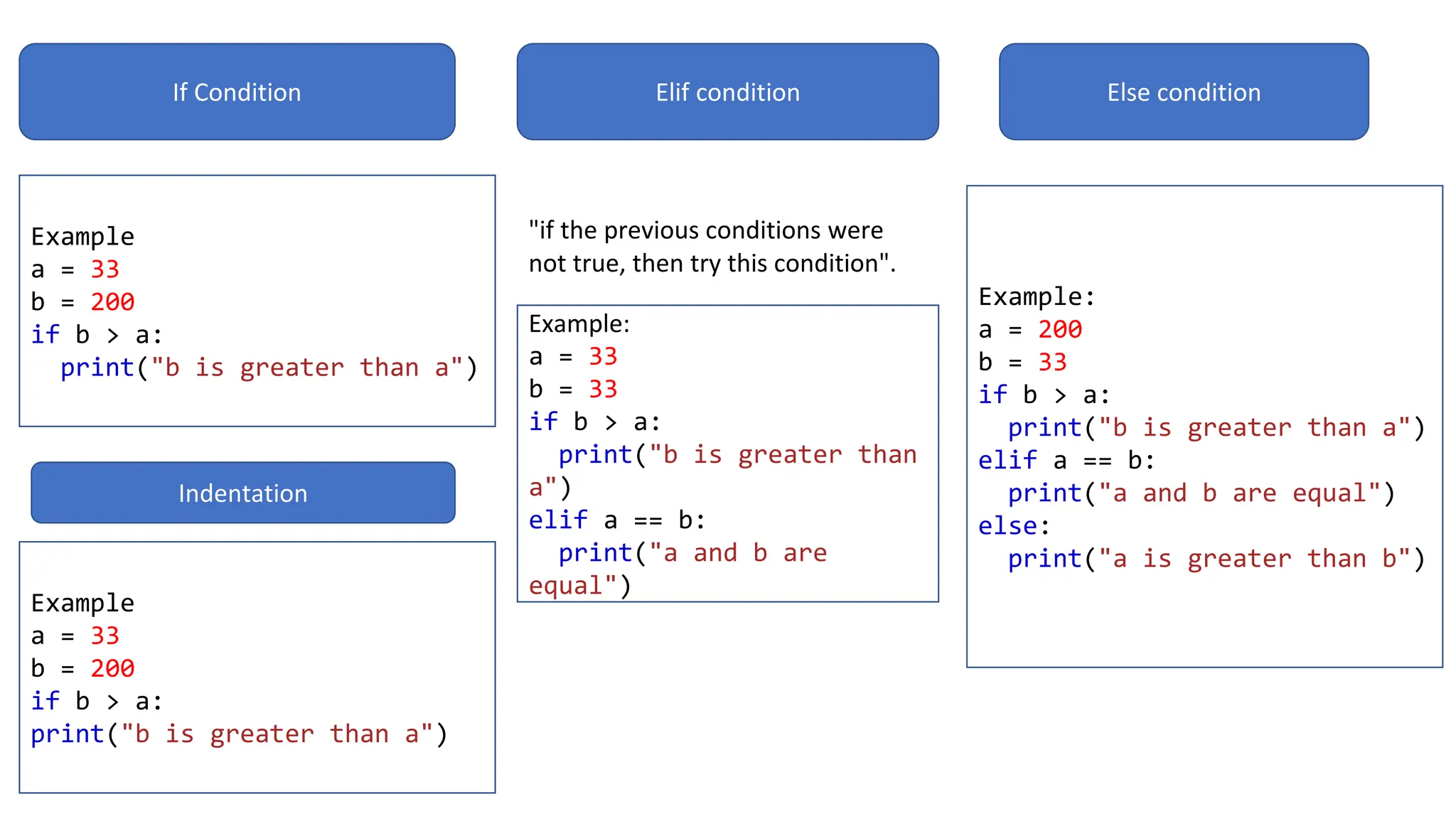
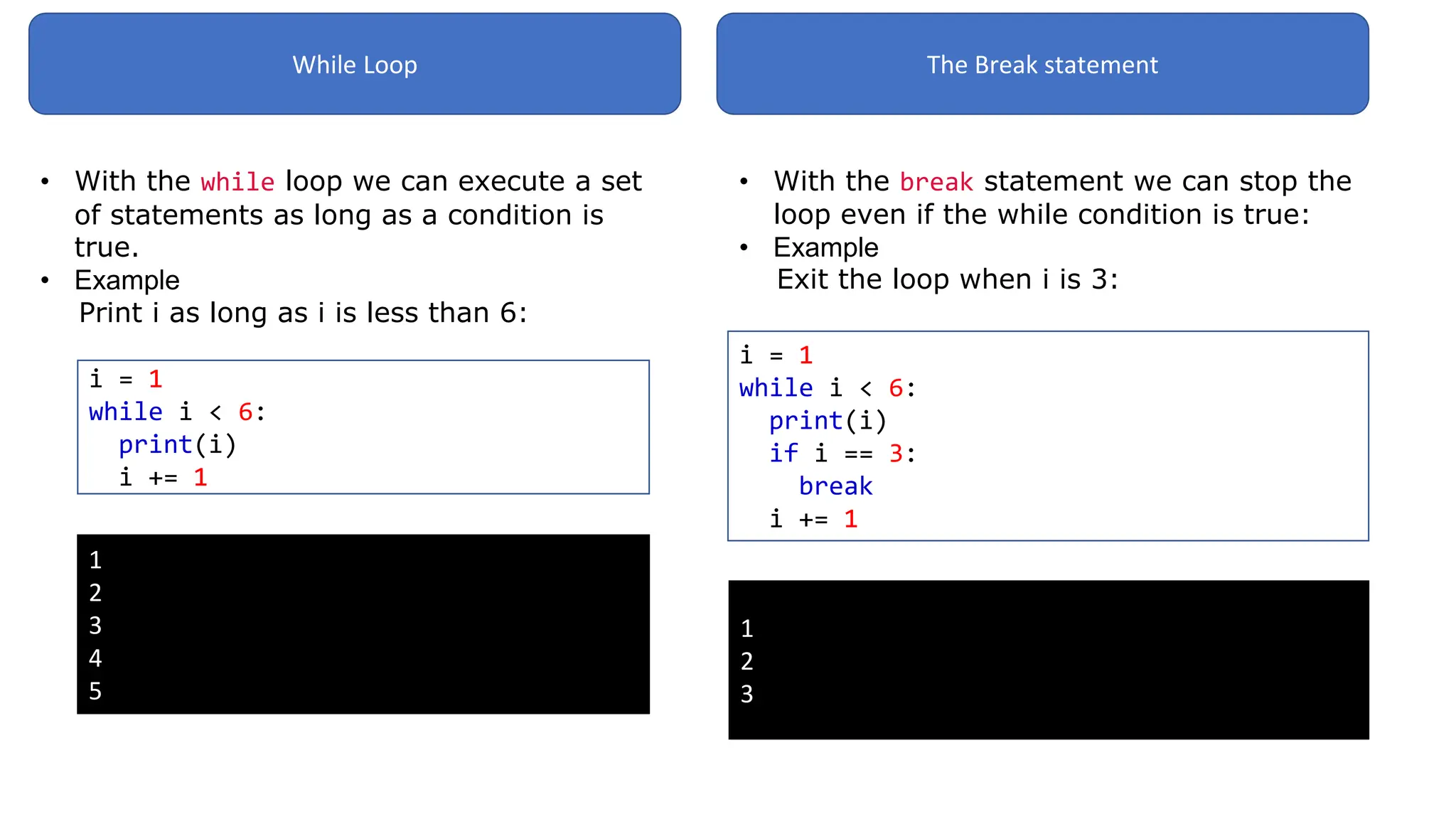
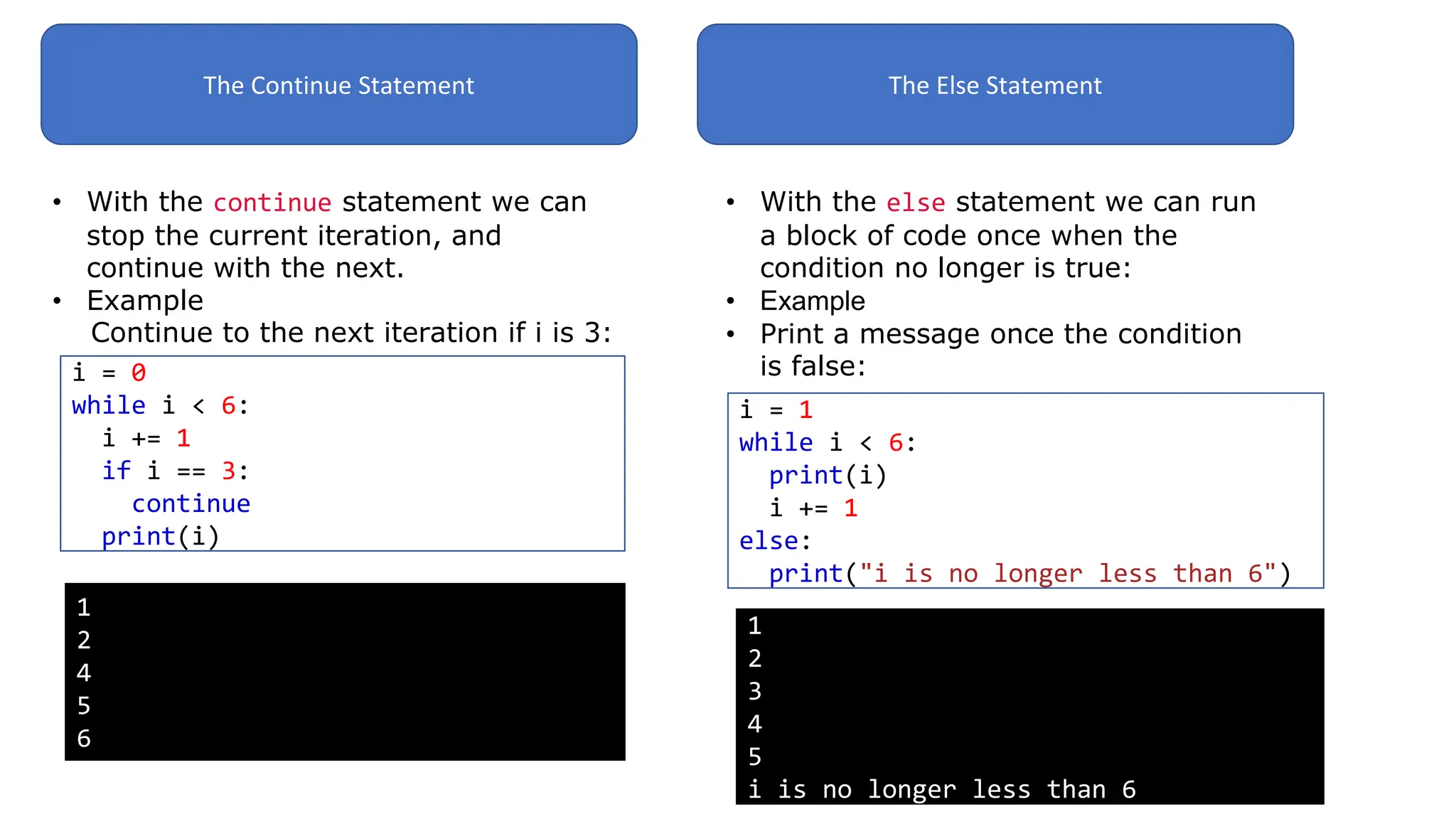
![For Loop Looping Through a String
• A for loop is used for iterating over a
sequence
• Example
Print each fruit in a fruit list:
fruits = ["apple", "banana", "cherry"]
for x in fruits:
print(x)
apple
banana
cherry
• Even strings are iterable objects, they
contain a sequence of characters:
• Example
Loop through the letters in the word
"banana":
for x in "banana":
print(x)
b
a
n
a
n
a](https://image.slidesharecdn.com/pythonprogramming-240413151503-8fa7dc50/75/Python-Programming-for-basic-beginners-pptx-22-2048.jpg)
![The break Statement The continue Statement
• With the break statement we can stop
the loop before it has looped through
all the items:
• Example
Exit the loop when x is "banan":
fruits =
["apple", "banana", "cherry"]
for x in fruits:
print(x)
if x == "banana":
break
apple
banana
• With the continue statement we can
stop the current iteration of the loop,
and continue with the next:
• Example
Do not print banana:
fruits =
["apple", "banana", "cherry"]
for x in fruits:
if x == "banana":
continue
print(x)
apple
cherry](https://image.slidesharecdn.com/pythonprogramming-240413151503-8fa7dc50/75/Python-Programming-for-basic-beginners-pptx-23-2048.jpg)
